Trip Report: Guatemala
#1
Original Poster
Join Date: Apr 2022
Posts: 129
Likes: 0
Received 0 Likes
on
0 Posts
Trip Report: Guatemala
PART 1: INTRODUCTION, AND HISTORIC CENTER OF GUATEMALA
Introduction
This trip report covers a twelve-night visit to Guatemala that commenced on 30 August 2023, and covered three destinations: Guatemala City, Antigua, and Quetzaltenango.
Trip “commentary” might have been a more appropriate title for what follows than trip “report,” for it may not quite be sufficient for readers ready to prepare a detailed and typical itinerary. I visited only three cities, of which only Antigua is a major tourist destination. And for a couple of personal issues, neither having anything directly to do with Guatemala, I didn’t get around in any of those three quite as much as I would have liked to. Furthermore, I am not a “foodie” — far from it — so I rarely offer restaurant reviews, and even when I do, there will be no guarantee that real foodies will appreciate my evaluations.
For those who are still reading, I’ll point out that despite those limitations, this was a rewarding trip to a great country, and after every such trip I make, I like to pay the country back, if necessarily in a humble way, by offering the kind of positive report that it deserves, provided I can do so honestly (and I certainly can here). So even if I may not be able to offer quite the sort of tourist detail that you will be able to build a typical tourist itinerary around, I will offer some general and historical commentary that I hope may be of some interest, particularly to the more curious and independent sorts. Anyway, there aren’t a lot of recent Guatemala reports on this forum, so even though Guatemala merits a more comprehensive report that I have written, I believe it deserves something; hence my decision to post this one.
I will start with a general comment, on a subject always of concern to first-time travellers to this region, which is safety; and the comment is that I found the places I visited to be generally safe. (I could say the same about the four other Central American countries I’ve visited, recently or in past years, but we’ll stick with Guatemala for now.) I realize that my one pesonal case doesn’t prove anything, and I’ll also acknowledge some familiarity I’ve acquired over the years with the general Latin-American scene; but I can honestly say that I experienced no safety issues on this Guatemala trip, nor did I even encounter a sense of danger. Everywhere it was just normal people, men, women, and families, going about their ordinary business; nobody seemed to be hukering down in fear, and so neither did I. Basically, you need just to follow what we call the “normal precaustions,” except that here, as in many Latin American countries, you may want to follow them a little more scrupulously than you would, say, in Norway. (Maybe you can get away with wandering around Oslo, drunk, at 2:00am; I wouldn’t try that in Guatemala City.) And in fact, as I live in the US, where people get gunned down in public routinely, and often at random, by well-armed loonies, I find my trips to Central America (where that, at least, doesn’t happen) are usually a relief.
Guatemala City, Zone 1
I spent three nights lodging in the historic center, in the middle of Zone 1 of Guatemala City (GC). For reasons I won’t go into, I wasn’t able to get around the the city, though I did get a good cross-sectional view of the sprawling capital on a long, long taxi ride from the airport, to my hotel, in the heavy traffic. Many tourists evade Guatemala City altogether, heading from the airport immediately to Antigua — which is actually quite easy to do now, with several taxis and shuttles making the trip routinely. And I can’t really blame tourists for doing this, for few tourists will want to sacrifice time at Guatemala’s other great distinations, in order to spend more time in the busy capital. And as you can learn within a few minutes of internet research, most tourists who do stay in GC lodge in safe, familiar, reassuring Zone 10, which I suppose does offer the best range of hotels, restaurants, and night-life spots.
I spent nearly all my time in in area from the central plaza (Constitution Plaza) south to 13 calle, between 5 ands 10 avenidas. I did not find this area to be as bad as many think it is, and in fact not really bad at all. In particular it did not seem unsafe, at least not by day and early evening. Essentially, it was a busy, typical big-city business center, with mostly oridnary people going about their normal business. A stroll down the district’s shopping streets, like 8 calle along the south-east side of the plaza or, better yet, 6 avenida (popular enough to be known simply as “The Sixth,” or La Sexta), should be sufficient to relieve any fears you might have of being out and about.
(I would not wander around the historic center late at night, but neither would I do so here in downtown Pittsburgh. And note that there are some bad neighborhoods on the outskirts of the central historic center, like “La Linea” to the northeast.)
The histortic center does not offer the quaint historical ambience of a colonial city like Antigua, and it may not be for everybody, but it offers enough points of interest to merit a visit from the curious. Constitution Plaza is a grand sight, still offering a subtle reminder that in its late-18th century heyday, Guatemala City, the seat of the entire “Captaincy-General” of Central America, was one of the great capitals of Spanish America. And personally, I was pleased to see, finally, the place where Miguel Asturias’s great novel, El Señor Presidente, opens, though I realize that today’s plaza is rather different from what it was when the novel takes place. In particular, the National Palace, which dominates today’s plaza, wasn’t there when the novel’s disturbed beggar Pelele murdered Colonel Parrales, though the cathedral before which this scene takes place was.
Elsewhere, I found some interesting folkloric displays open to the public in the San Carlos University. At first glance, upon entering, it seemed to be quite a tourist attraction, but in a moment I realized that most of the people inside were students, for this is still a functioning university. Not far from here is a great history museum that covers Guatemala from independence, through the 1954 CIA coup that toppled the democratically elected government of Jacobo Arbenz.
By a lucky coincidence I happened to be in Guatemala City during the late-August Book Fair, when the long south side of the plaza was lined with book stalls. But I’m afraid the time I spent browsing there distracted me from taking a closer look at the Cathedral; across the plaza it was only later that I learned that the names of many victims of the troubles of the 1970s and 80s have been inscribed on the cathedral’s pillars.
I spent my three nights in the historic center at the old, reliable Hotel Spring, and I quite satisfied with it. And as I’ve already mentioned, I usually don’t do restaurant reviews, but I will mention a couple of restaurants I liked, not too far from each other on 7 avenida, a few blocks south of the plaza. Though neither specializes in traditional Guatemalan food (which is what real foodies should travel to Guatemala for), they’re worth mentioning. One is Cafe Amore, a friendly little place with a sort of Italian-leaning menu. I have no idea how the smug set will compare it to the celebrity-chef restaurants they remember from Venice, and in fact I had only a panino, an Italian-style sandwich, but I thought it was fine. And a short walk up 7 avenida is Astoria, a German-style delicatessan and restaurant. I liked the place myself, though I’ll refrain from a professional ssessment, German food being one of the reasons I’m not a foodie; but I dined there with another guest at the Spring who happened to be acquainted with German food, and she seemed very
pleased with the port dish she ordered.
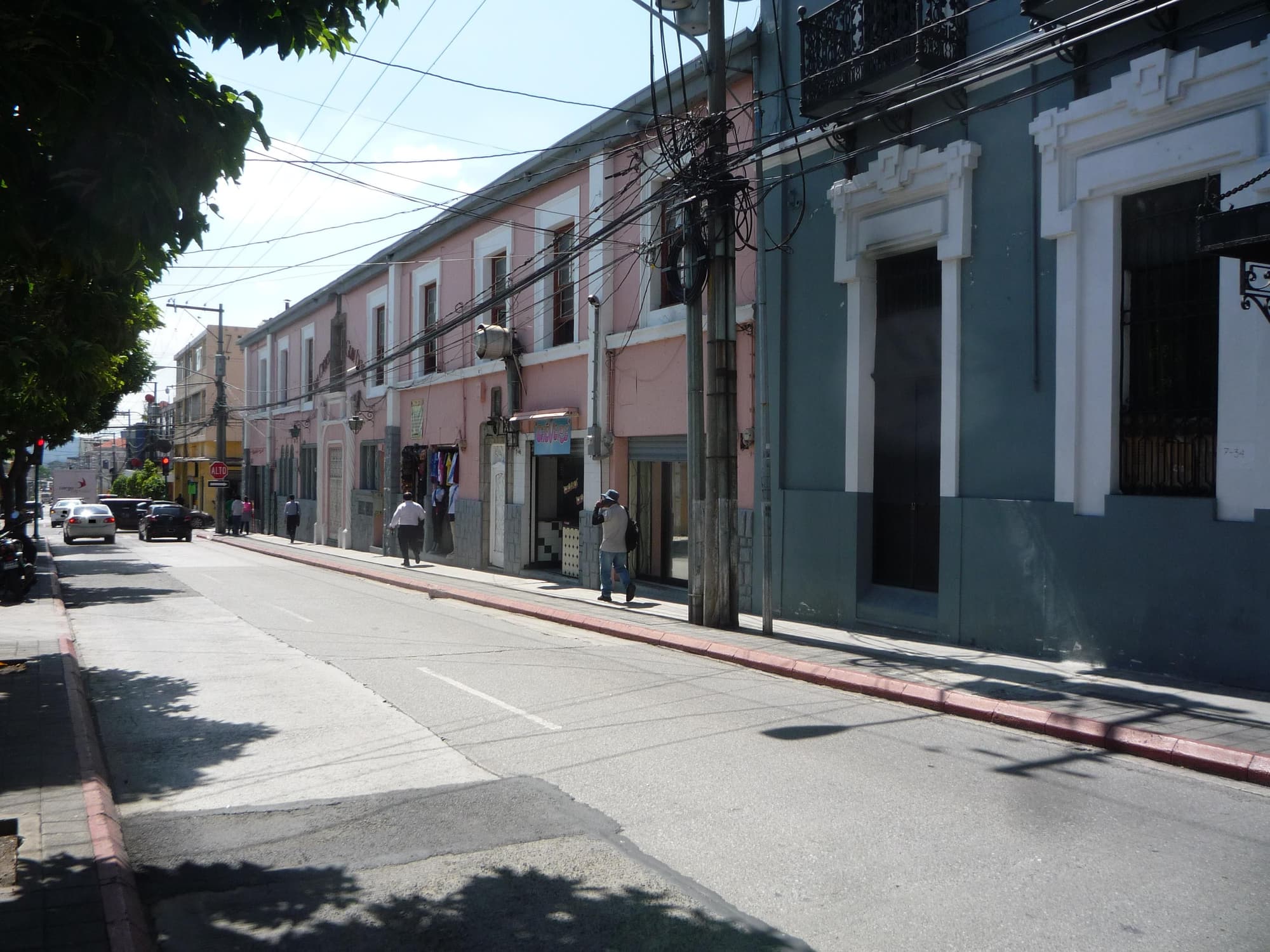
A street in the historic center.

An invitingly long row of book stalls along the south side of Constitution Plaza.

The National Palace of Culture, on the north side of the plaza.
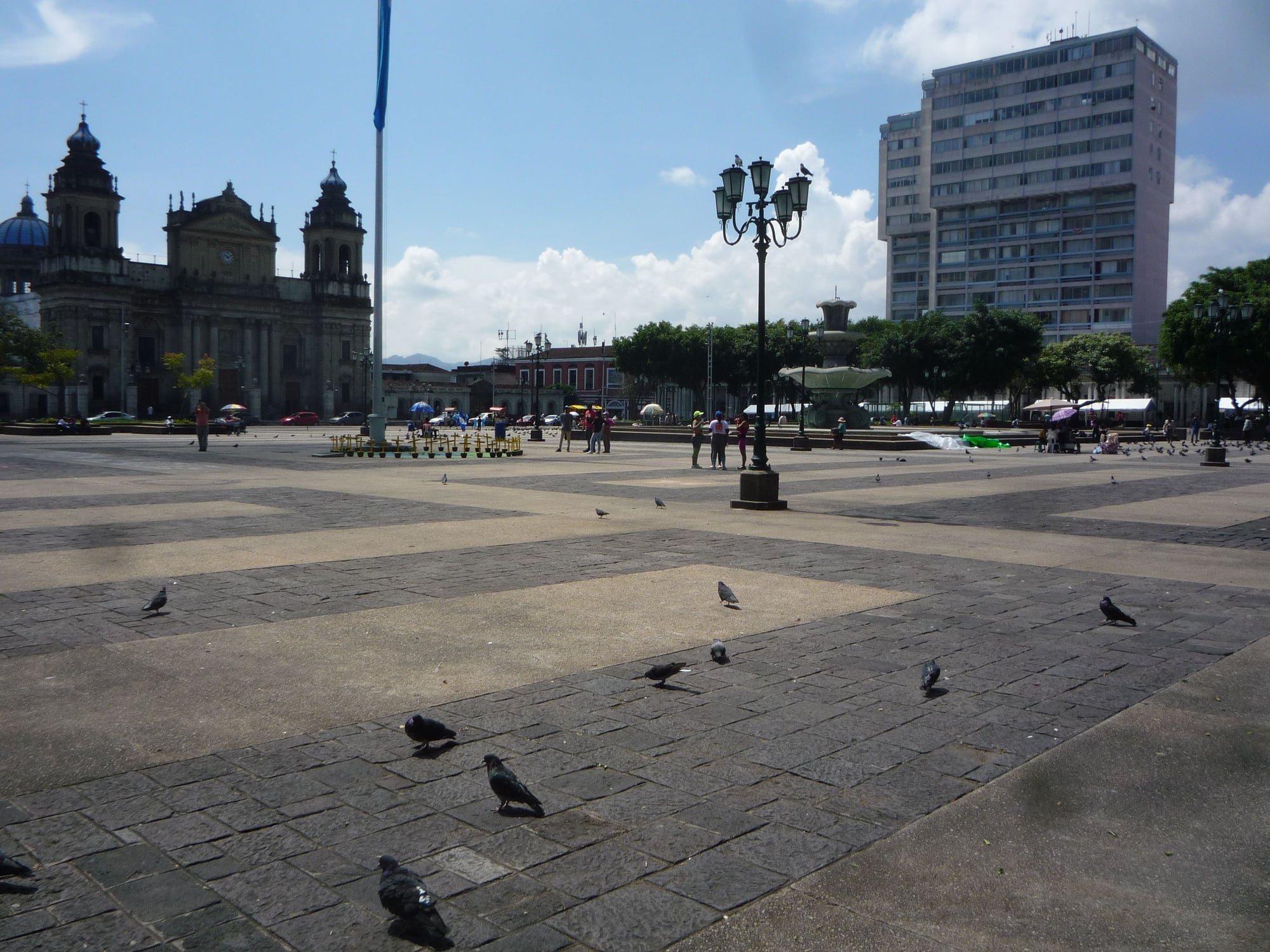
Looking towards the SE corner of the plaza, with the cathedral to the left.
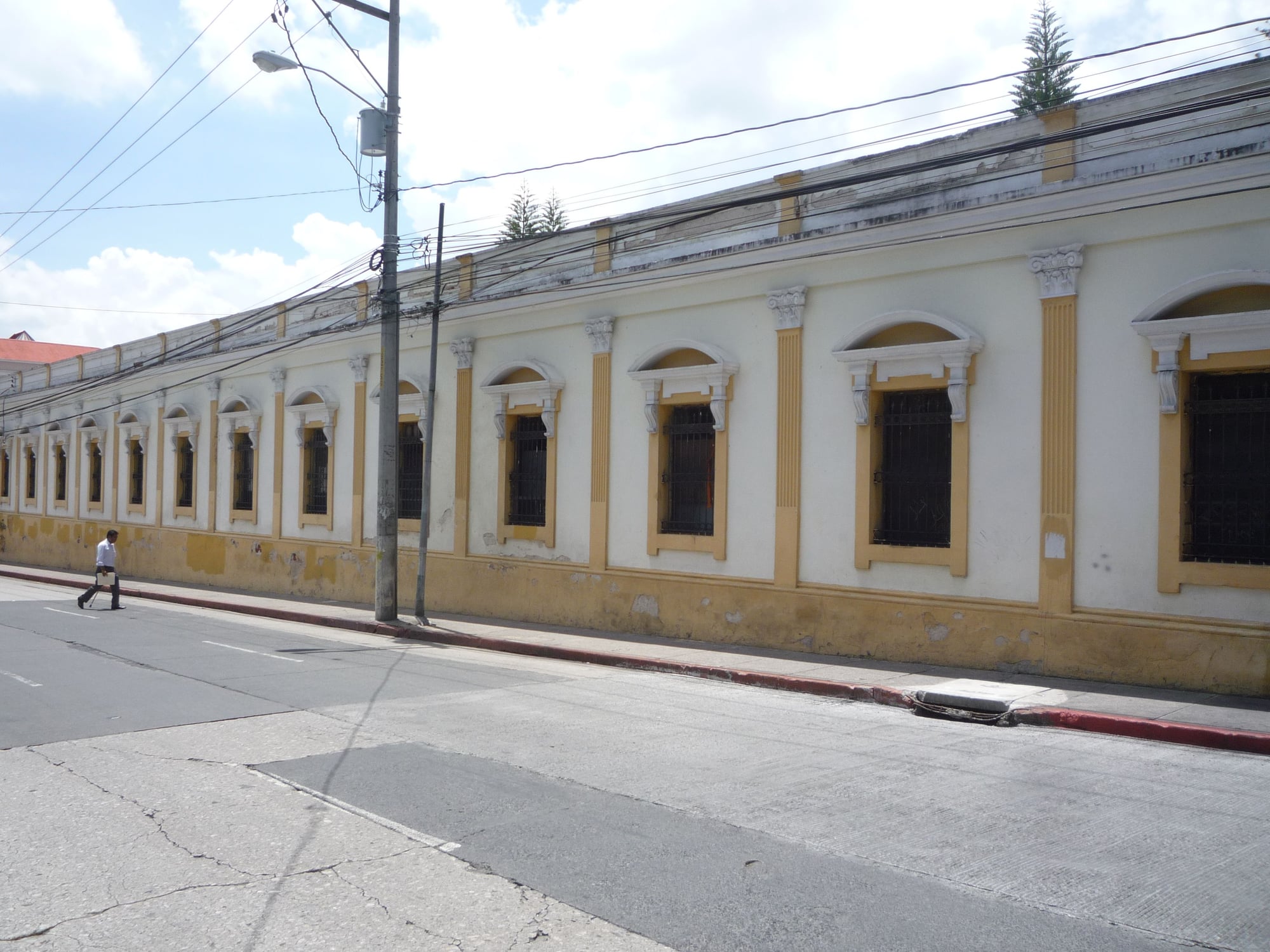
The University of San Carlos. It’s still a functioning university, but on the ground floor several rooms offering cultural or historic displays were open to the public.

The former home of Mariano Beltranena y Llanos, a prominent liberal politician of the 1820s, who signed the declaratiojn of independence from Spain and who later served — very briefly — as president of the Central American Federation. (This is now known as the Ibargüen House, after the family that once owned it.)
Introduction
This trip report covers a twelve-night visit to Guatemala that commenced on 30 August 2023, and covered three destinations: Guatemala City, Antigua, and Quetzaltenango.
Trip “commentary” might have been a more appropriate title for what follows than trip “report,” for it may not quite be sufficient for readers ready to prepare a detailed and typical itinerary. I visited only three cities, of which only Antigua is a major tourist destination. And for a couple of personal issues, neither having anything directly to do with Guatemala, I didn’t get around in any of those three quite as much as I would have liked to. Furthermore, I am not a “foodie” — far from it — so I rarely offer restaurant reviews, and even when I do, there will be no guarantee that real foodies will appreciate my evaluations.
For those who are still reading, I’ll point out that despite those limitations, this was a rewarding trip to a great country, and after every such trip I make, I like to pay the country back, if necessarily in a humble way, by offering the kind of positive report that it deserves, provided I can do so honestly (and I certainly can here). So even if I may not be able to offer quite the sort of tourist detail that you will be able to build a typical tourist itinerary around, I will offer some general and historical commentary that I hope may be of some interest, particularly to the more curious and independent sorts. Anyway, there aren’t a lot of recent Guatemala reports on this forum, so even though Guatemala merits a more comprehensive report that I have written, I believe it deserves something; hence my decision to post this one.
I will start with a general comment, on a subject always of concern to first-time travellers to this region, which is safety; and the comment is that I found the places I visited to be generally safe. (I could say the same about the four other Central American countries I’ve visited, recently or in past years, but we’ll stick with Guatemala for now.) I realize that my one pesonal case doesn’t prove anything, and I’ll also acknowledge some familiarity I’ve acquired over the years with the general Latin-American scene; but I can honestly say that I experienced no safety issues on this Guatemala trip, nor did I even encounter a sense of danger. Everywhere it was just normal people, men, women, and families, going about their ordinary business; nobody seemed to be hukering down in fear, and so neither did I. Basically, you need just to follow what we call the “normal precaustions,” except that here, as in many Latin American countries, you may want to follow them a little more scrupulously than you would, say, in Norway. (Maybe you can get away with wandering around Oslo, drunk, at 2:00am; I wouldn’t try that in Guatemala City.) And in fact, as I live in the US, where people get gunned down in public routinely, and often at random, by well-armed loonies, I find my trips to Central America (where that, at least, doesn’t happen) are usually a relief.
Guatemala City, Zone 1
I spent three nights lodging in the historic center, in the middle of Zone 1 of Guatemala City (GC). For reasons I won’t go into, I wasn’t able to get around the the city, though I did get a good cross-sectional view of the sprawling capital on a long, long taxi ride from the airport, to my hotel, in the heavy traffic. Many tourists evade Guatemala City altogether, heading from the airport immediately to Antigua — which is actually quite easy to do now, with several taxis and shuttles making the trip routinely. And I can’t really blame tourists for doing this, for few tourists will want to sacrifice time at Guatemala’s other great distinations, in order to spend more time in the busy capital. And as you can learn within a few minutes of internet research, most tourists who do stay in GC lodge in safe, familiar, reassuring Zone 10, which I suppose does offer the best range of hotels, restaurants, and night-life spots.
I spent nearly all my time in in area from the central plaza (Constitution Plaza) south to 13 calle, between 5 ands 10 avenidas. I did not find this area to be as bad as many think it is, and in fact not really bad at all. In particular it did not seem unsafe, at least not by day and early evening. Essentially, it was a busy, typical big-city business center, with mostly oridnary people going about their normal business. A stroll down the district’s shopping streets, like 8 calle along the south-east side of the plaza or, better yet, 6 avenida (popular enough to be known simply as “The Sixth,” or La Sexta), should be sufficient to relieve any fears you might have of being out and about.
(I would not wander around the historic center late at night, but neither would I do so here in downtown Pittsburgh. And note that there are some bad neighborhoods on the outskirts of the central historic center, like “La Linea” to the northeast.)
The histortic center does not offer the quaint historical ambience of a colonial city like Antigua, and it may not be for everybody, but it offers enough points of interest to merit a visit from the curious. Constitution Plaza is a grand sight, still offering a subtle reminder that in its late-18th century heyday, Guatemala City, the seat of the entire “Captaincy-General” of Central America, was one of the great capitals of Spanish America. And personally, I was pleased to see, finally, the place where Miguel Asturias’s great novel, El Señor Presidente, opens, though I realize that today’s plaza is rather different from what it was when the novel takes place. In particular, the National Palace, which dominates today’s plaza, wasn’t there when the novel’s disturbed beggar Pelele murdered Colonel Parrales, though the cathedral before which this scene takes place was.
Elsewhere, I found some interesting folkloric displays open to the public in the San Carlos University. At first glance, upon entering, it seemed to be quite a tourist attraction, but in a moment I realized that most of the people inside were students, for this is still a functioning university. Not far from here is a great history museum that covers Guatemala from independence, through the 1954 CIA coup that toppled the democratically elected government of Jacobo Arbenz.
By a lucky coincidence I happened to be in Guatemala City during the late-August Book Fair, when the long south side of the plaza was lined with book stalls. But I’m afraid the time I spent browsing there distracted me from taking a closer look at the Cathedral; across the plaza it was only later that I learned that the names of many victims of the troubles of the 1970s and 80s have been inscribed on the cathedral’s pillars.
I spent my three nights in the historic center at the old, reliable Hotel Spring, and I quite satisfied with it. And as I’ve already mentioned, I usually don’t do restaurant reviews, but I will mention a couple of restaurants I liked, not too far from each other on 7 avenida, a few blocks south of the plaza. Though neither specializes in traditional Guatemalan food (which is what real foodies should travel to Guatemala for), they’re worth mentioning. One is Cafe Amore, a friendly little place with a sort of Italian-leaning menu. I have no idea how the smug set will compare it to the celebrity-chef restaurants they remember from Venice, and in fact I had only a panino, an Italian-style sandwich, but I thought it was fine. And a short walk up 7 avenida is Astoria, a German-style delicatessan and restaurant. I liked the place myself, though I’ll refrain from a professional ssessment, German food being one of the reasons I’m not a foodie; but I dined there with another guest at the Spring who happened to be acquainted with German food, and she seemed very
pleased with the port dish she ordered.

A street in the historic center.

An invitingly long row of book stalls along the south side of Constitution Plaza.

The National Palace of Culture, on the north side of the plaza.

Looking towards the SE corner of the plaza, with the cathedral to the left.

The University of San Carlos. It’s still a functioning university, but on the ground floor several rooms offering cultural or historic displays were open to the public.

The former home of Mariano Beltranena y Llanos, a prominent liberal politician of the 1820s, who signed the declaratiojn of independence from Spain and who later served — very briefly — as president of the Central American Federation. (This is now known as the Ibargüen House, after the family that once owned it.)
#2
Original Poster
Join Date: Apr 2022
Posts: 129
Likes: 0
Received 0 Likes
on
0 Posts
Trip Report: Antigua Guatemala
Antigua Guatemala
The first Spanish capital of this country, the "City of the Knights of St. James of Guatemala," or Ciudad de los Caballeros de Santiago de Guatemala (the Spanish had a way with city names), was founded in 1524 where today's Tecpan Guatemala is situated, but after three years of determined resistance by the Cakchiquel Mayas, the Knights of St. James called it quits and moved about 20 miles to the south-east. This second capital lasted about 14 years, when near-by Volcan Agua, or "Water Volcano," blew. The conquistadors moved their capital once again, though only about 5 miles further, and this time lucked out — the City of the Knights of St. James #3 lasted exactly 230 years before an earthquake made a fourth (and so-far final) move mecessarily. But third capital was rebuilt, and renamed simply Antigua Guatemala, or "Old Guatemala," now just Antigua.
Antigua is one of the major tourist destinations of Guatemala, and desrvedly so. As a result there’s not really a lot I can say about it, tourism-wise, that hasn’t been said many times before; I can only agree with the best of the reviews. In fact, it is popular enough with tourists that I might have overlooked it myself; however, I happen to love spending time in old Spanish colonial towns, and anyway, Antigua is so close to the capital, and so easy to reach from there, that it's impossible to justify missing it.
But that said, I found the tourism effect palpable. Not just the very presence of tourists, but in the ways the city has adapted to them -- a much wider range of lodgings and restaurants than one might expct in an old Spanish town, numerous travel agencies, and souvenirs and traditional artefacts sold everywhere on the streets, in the plazas, and in established shops. But still, I’m willing to cut Guatemala some slack here, and refrain from complaining. For my first visit to Antigua, decades ago, was during the years of counterinsurgency, when tourism here, and elsewhere in the country, had dropped significantly. Antigua and Panajachel, so derserving of visitors, were unnaturally quiet. So today, with those reminisences in mind, I found the sight of all those tall, blond people walking about Antigua in their shorts and day-packs actually to be a good sign.
Furthermore, the tourist presence here fell far, far short of the hordes I saw in those horrifying travel-news photos from Europe this past summer. And I found that if Antigua has adapted to tourism, it has done so nicely -- it is kept up well, it remains a beautiful old Spanish city; and walking the streets in my usual "flâneur" style, I could still almost imagine from time to time, if only briefly, that I was still in the eighteenth century. (The parked cars spoiled the effect a bit.)
As I mentioned above, the many tourists who want to bail out of Guatemala City as quickly as possible can usually do so immediately from the international airport, with shuttles, taxis, and I believe even Uber going from there directly to Antigua. The trip is not excessive, Antigua not being far from the international airport, though no one seems to know quite how far — the diverse figures I’ve seen seem to converge around 24 miles, which also basically agrees with my own map measurement. Be aware that mainly due to the long winding haul through the busy Guatemala City outskirts, it may seem like a long 24 miles.
A few sights
Volcan Agua, the “Water Volcano,” is so-called because after a long period of dormancy, during which a lake had formed in its crater, the first effect after it finally blasted again in 1541 was a muddy flood cascading down. The Guatemalan scholar and writer Luis Cardoza y Aragon called Volcan Agua “the navel of Guatemala,” and ”the lookout of the original gods”, and while the world’s various societies have all had their respective ideas about where the navel of the world might be, even the agnostics among us will admit that Volcan Agua is truly what a god’s lookout ought to be, given the way it looms over the city from the south. Look down almost any south-bound street, and you’ll see it in the near distance. Enjoy breakfast on the roof-top patio of the Hotel Saleh, as I did, and it will practically be in your face. If you need an even closer look, you can hike to the top. I didn’t do so this time, though I attempted it on that earlier visit, a long time ago. (I didn’t make it to the top, but only because a tumbling stone smashed a finger of one of my companions, forcing us to rush back into town — a tricky thing to do from three-quarters of the way up a violcano — so he could get medical care.)
It seems that one of the most frequently photographed sights in Antigua is the Santa Catalina arch, which spans 5 avenue about two blocks north of the central plaza. Almost any illustrated guidebook or article on Antigua will have such a photo (one of my books has two), even if it has no others. And I admit it’s nice-looking; as arches go, though maybe not the city’s most photogenic sight. It was built in the 17th century to connect two parts of a convent, so that the nuns could cross from the one part to the other without going into the street, or even being seen. But perhaps because it appears so often in photos, it seems to attract tourists, and indeed the tourist concentration along this stretch of fifth avenue, under the arch, seemed to be far greater than what I saw anywhere else. And perhaps for that reason, the street seemed a litle tackier than most others in the city, though it’s all relative — if you could transport this stretch of fifth avenue to Zone 1 in Guatemala City, it would look fantastic. (In fact there’s a similar arch in Zone 1 of GC — even a bit nicer looking than Santa Catalina in my opinion — though it has not attracted the tourists or travel photographers yet. If arches are your scene, you’ll find that one spanning 12 calle, where it intersects 7 avenida.) But back in Antigua, once you have gazed at the Santa Catalina arch to your satisfaction, and taken your pictures, continue walking north to the elegant La Merced church, which is perhaps what more of those photographers really should be taking pictures of. Those with an interest in history, and in its better protagonists, may want to take time to admire the statue of Bartolome de las Casas, in the small square in front of the church.
At the opposite, quieter, south-east end of the city you will find the the San Francisco church and monastery. With both intact and somewhat ruined structures, I found it to be an enjoyable place just to amble about on my own; but also interesting was the story of its most famous priest, Pedro de San Jose Betancur, who resided there during the mid 17th century. One of his practices was to walk the streets of the city in the evenings, ringing a bell and asking people to pray for the souls in purgatory, which probably did not seem as odd in the 1660s as it might today. But he is known primarily for his charitable works, for which reason he is affectionately known as Hermano, or “Brother,” Pedro. Those works included miraculous cures (or so goes the official account), and a room adjacent to the church museum displays the many crutches, prosthetics, and memetos of gratitude left behind by the miraculously cured.
In the city center, I’ll also put in a good word for the ruins of the original San Jose cathedral, behind the present one. A travel companion I met up with for a couple of days declined to see it, on the not unreasonable grounds that it was, after all, smashed up; but with my sense for exploring what there is, regadless of grandeur or its lack, and also because I like large sites where I can amble about at will, I found it interesting enough. The ruins are actually impressive, and with some imagination, you can picture what a grand cathedral complex this must have been. But what I liked most was something relatively humble — on a large placard which gave a brief history of the cathedral reproduced in several languages, one of those languages was Mayan (either Cakchiquel or Quiche, I suspect), which I thought was a nice touch.
Though you can’t really miss it, I’ll call attention to the great national Museum of the Art of Guatemala (Spanish acronym MUNAG). The MUNAG was opened only two years ago, so it will be mentioned only in recent guidebooks and internet sites (the earlier museum at this site was known as the Museum of Santiago de los Caballeros). The grand building itself stretches along the entire southern side of the plaza, and in colonial times was the headquarters of the “Captains-General,” effectively the heads of government for Spanish Central America. (Technically, Central America was subordinate to the viceroy seated in Mexico City; but as the distance from that city to Guatemala was great, and as Mexico usually had enough issues of its own for the viceroy to handle, the Captain-Geneal often acted more or less independently.)
The MUNAG is a splendid museum, devoted to Guatemalan art and culture spanning the past 3000 years, right up to modern times. I’m not generally a fan of modern art, but in countries known mainly for ancient stuff, it can be interesting to see what the modern creators are doing. Don’t overlook the long first-floor balcony (second-floor in American English), from where you can gaze out over the plaza as the Captains-General themselves might have done.
As often when I’m in museums, my attention was grabbed most, not by any of the biggest, shiniest exhibits, but by a couple of the most inconspicuous ones — amidst the many ancient artefacts were two small figurines dated, rather imprecisely, to 800-250 BC, each of which resembled a wide-eyed young woman, or so it seemed to me, covering her mouth with both hands, as if interrupted in a moment of surprise or embarrassment. What impressed me was the “caught-in-time” expressiveness of these small figues, a sharp contrast with the stiff and stylized features we usually see in ancient sculpture, no matter where it’s from. Furthermore, they look exactly as people might look today if startled, though in the absence of contemporary writing, we may never know quite what the ancient artist had in mind when he made them. Honestly, if I had turned down an opportunity to see Michaelangelo’s David, in favor of these small figurines, I would have been pleased with my decision.
Hotels
My five non-consecutive nights in Antigua were spent in two reasonably-priced hotels, and I can recommend both: The Hotel Saleh, in the south-west part of the city, with more of a modern ambience (breakfast on the roof-top patio, with Volcan Agua right in front of you, is a highlight of a stay here). And the Posada de San Pedro, with a quaint ambience that goes nicely with this historic city, (I’m referring to the San Pedro on 3 avenida south, just south of 7 calle — there seemed to be a similarly-named hotel elsewhere in town.)
Dining
There are many great independent cafes and reastaurants in Antigua, and I would never recommend a global franchise to any visitor in a fine historic city like this. But if you want to live like a real Antigueño, at least for a few minutes, you may have to order a take-out pizza from the local “Little Caeser’s” place, for it seemed to be the thing to do — I constantly saw people walking about the city with their distinctive orange Little Caesar’s take-out pizza boxes in hand, often on their way to an outdoor lunch in the central plaza. (I would ask only that you toss the empty box into the trash, not onto the grass, or into a hedge, a practice not entirely unknown here.)
Otherwise, I can’t really offer any definitive recommendations, but then, you probably won’t need any, for there are cafes and restaurants of all sorts everywhere. For me, travel is primarily exploration, walking around and picking interesting-looking cafes as I pass them; and in Antigua, you usually don’t have to walk too far before passing at least a few.

Typical street scene in Antigua.
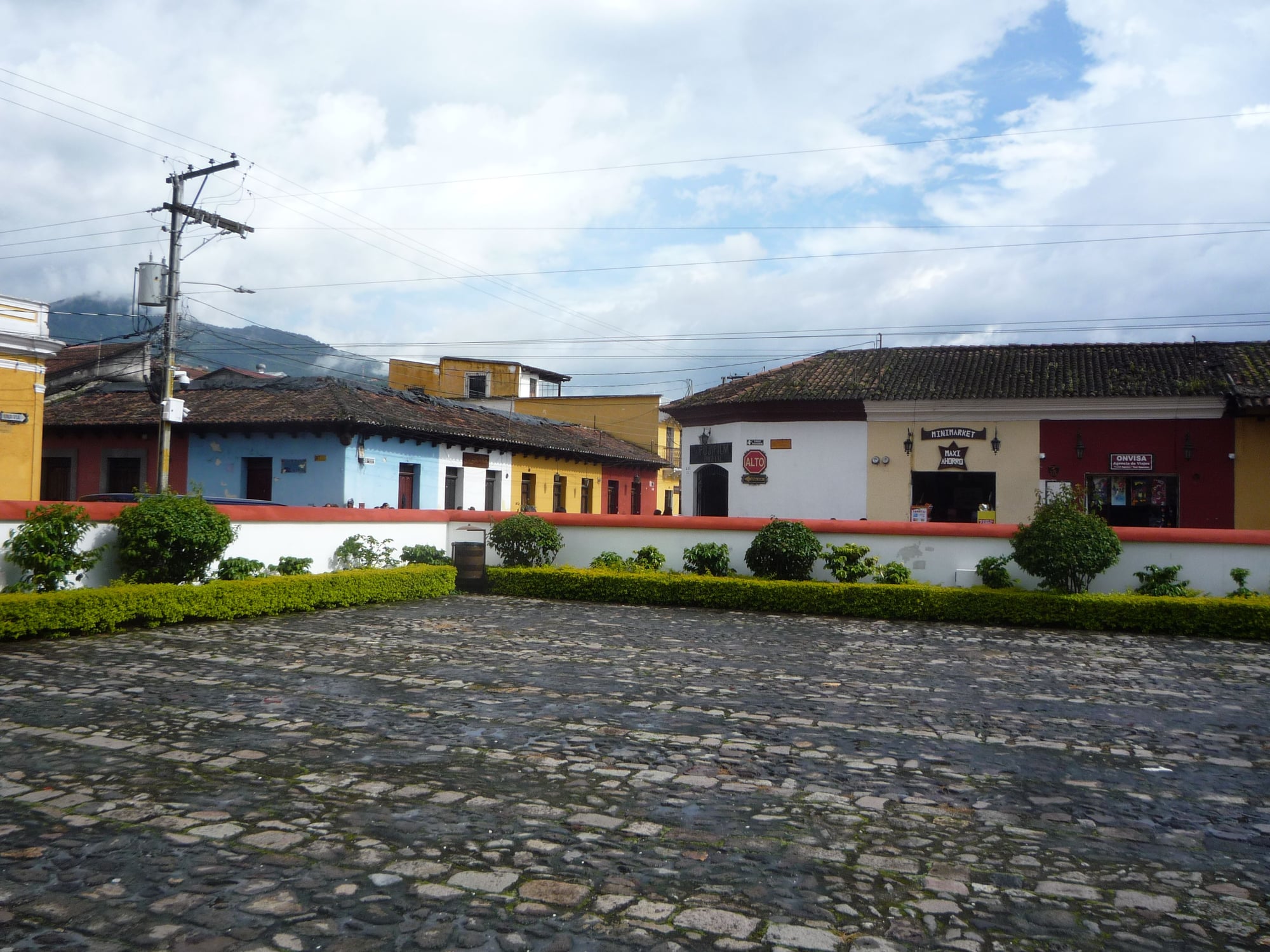
Typical street scene in Antigua.
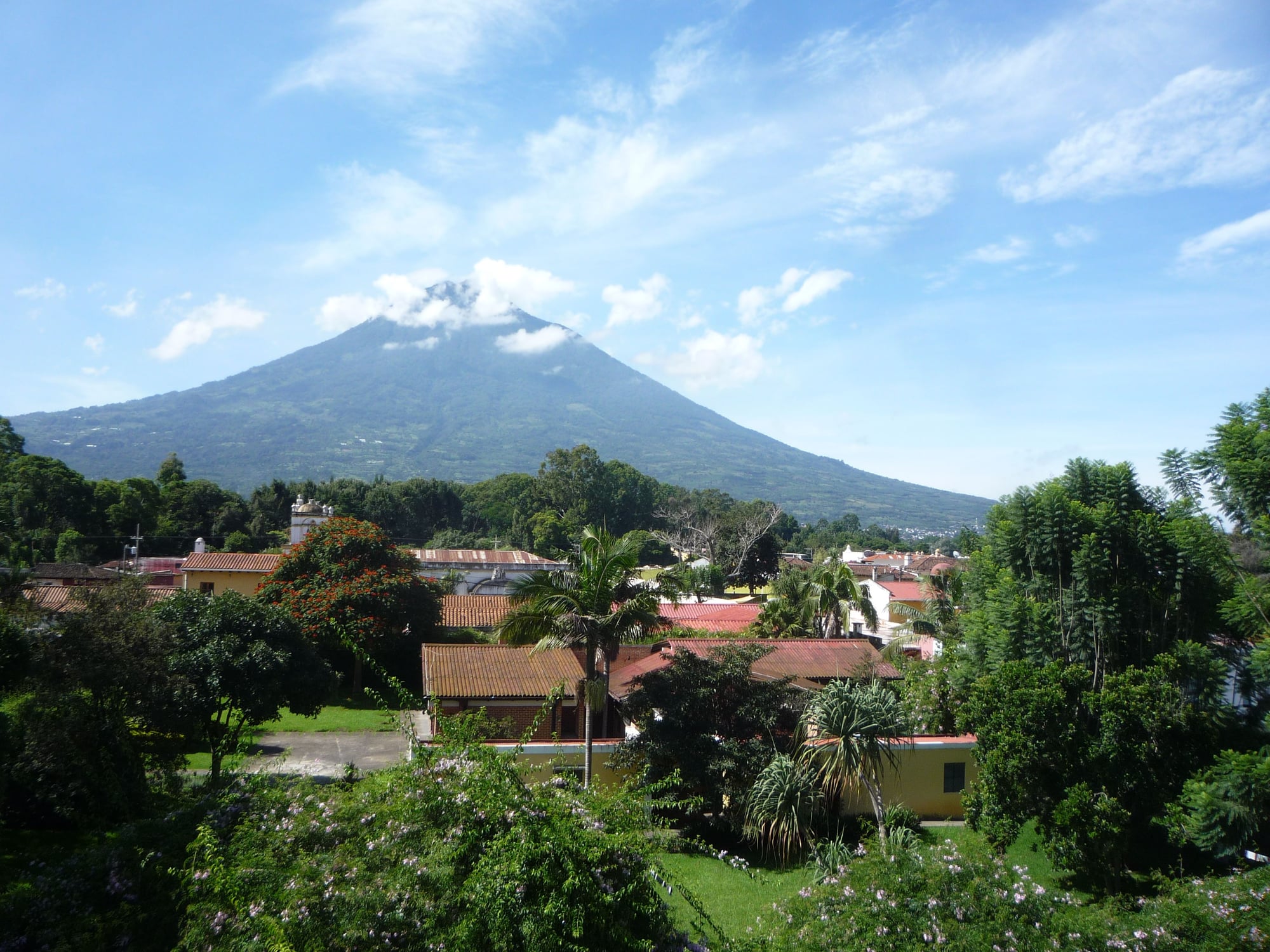
Volcan Agua, seen from the roof-top patio of my hotel.
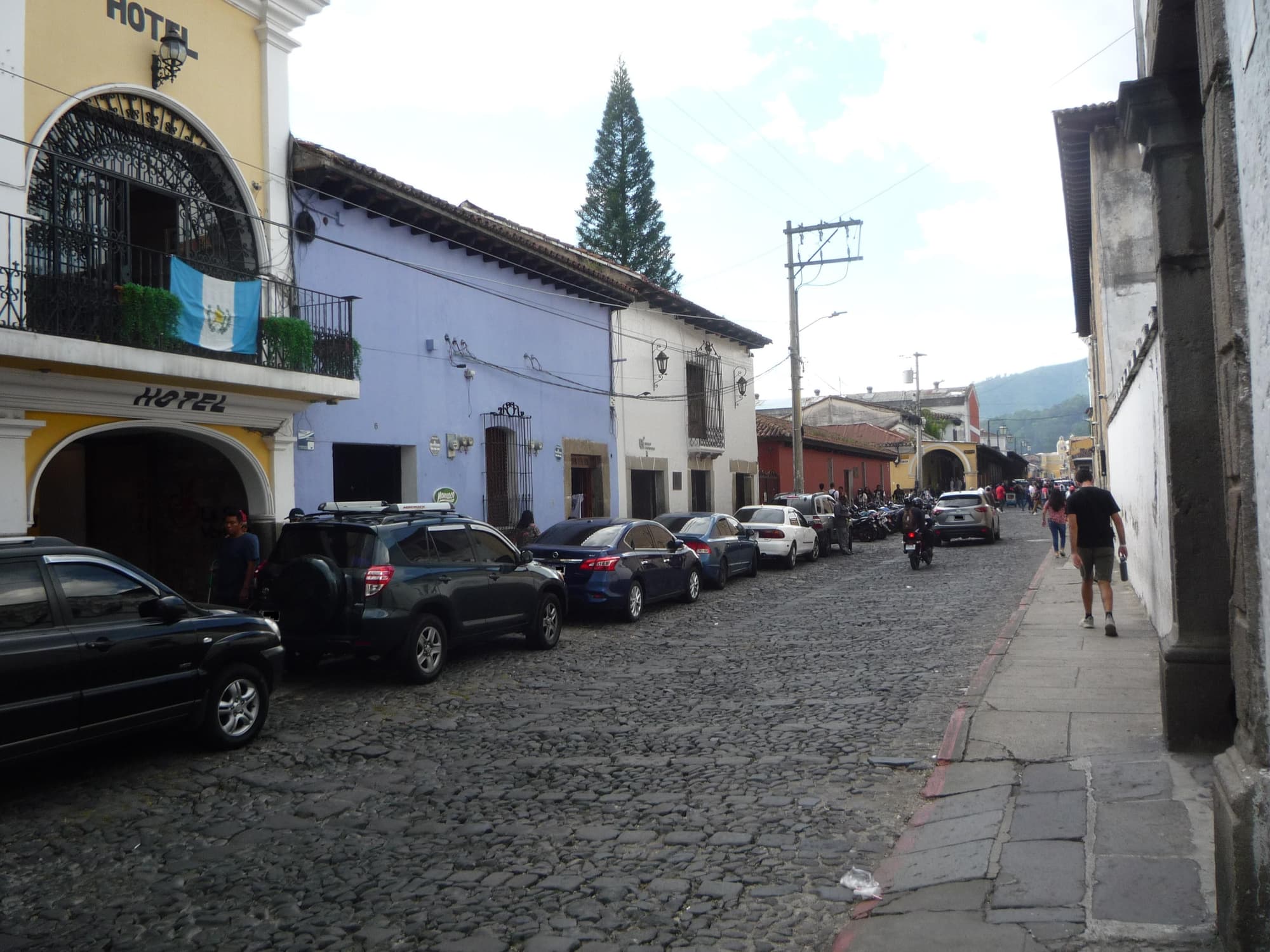
Fifth Avenue, just south of the plaza. The white building in the center was the birthplace (1886) of Adrian Recinos, a prominent Guatemalan scholar whose works include an authoritative Spanish translation of the Popol Vuh (the first version I read).
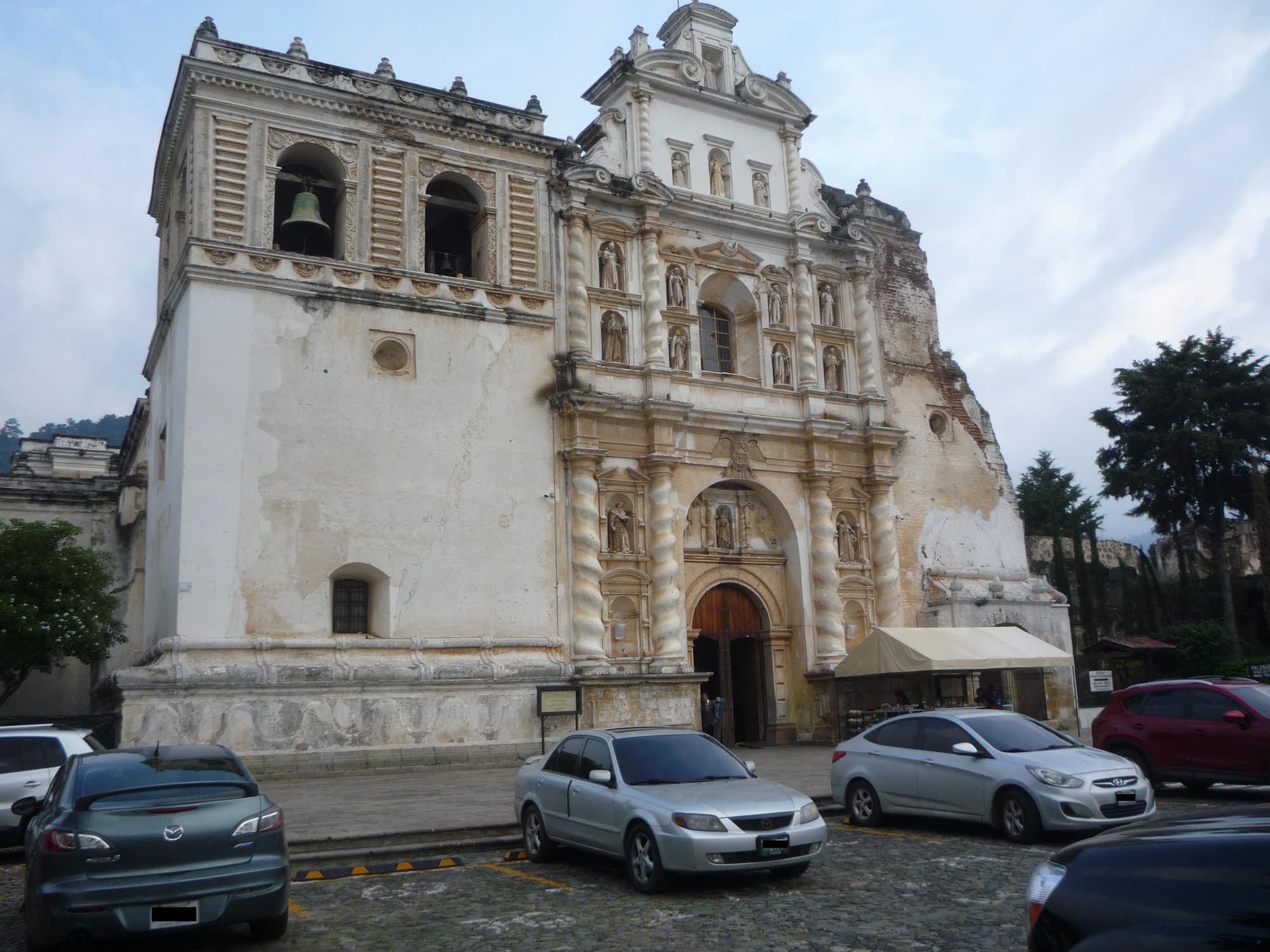
The San Francisco church, at the SE part of the city. It contains a museum which focuses on the life of “Brother Pedro” (Pedro de San José de Betnacur), a 17th century friar who resided here and became known for charitable and, allegedly, miraculous works.

Ruins of the original San José cathedral.
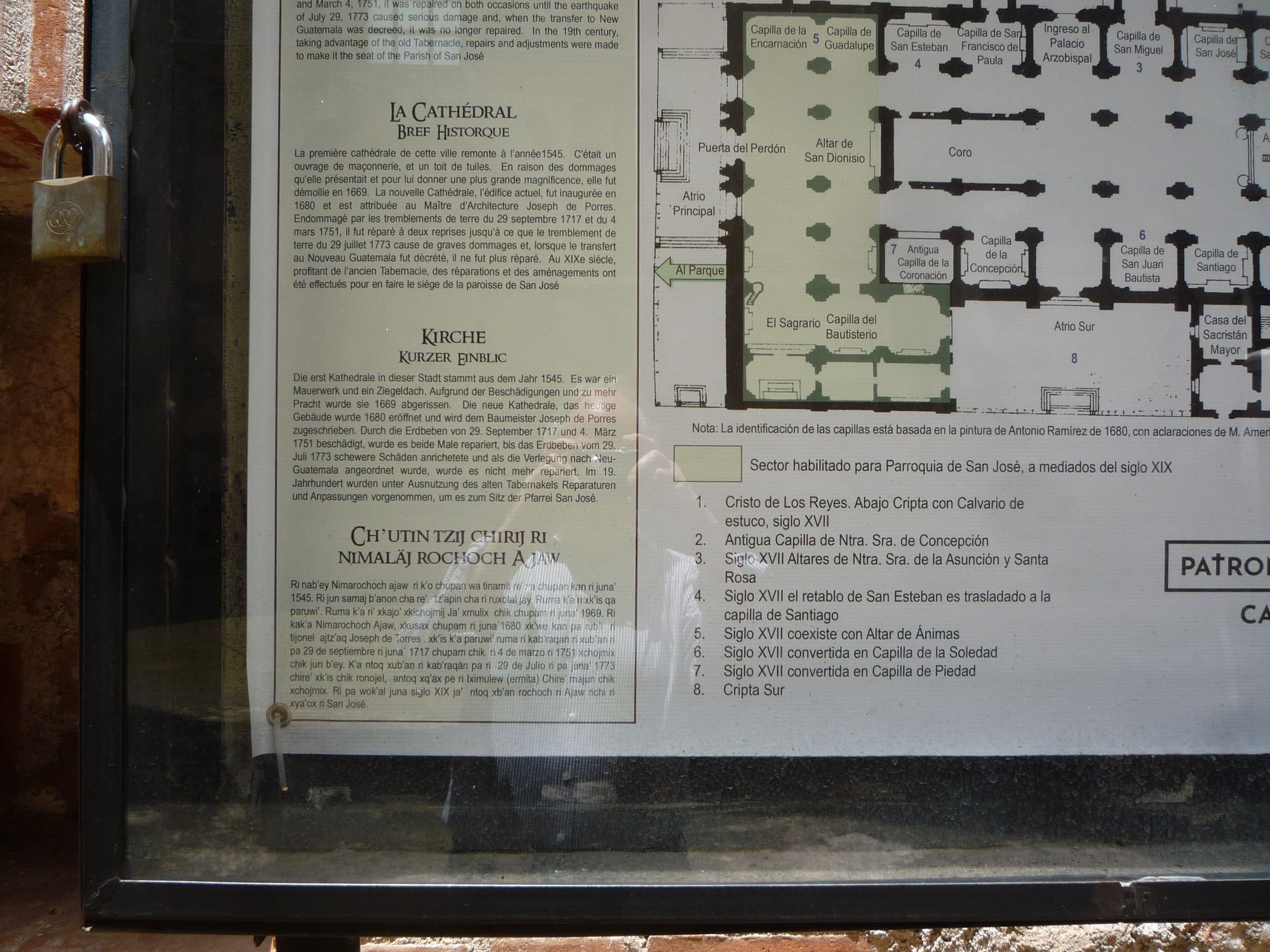
A brief history of the San José cathedral in several languages, including Chkchiquel Mayan.
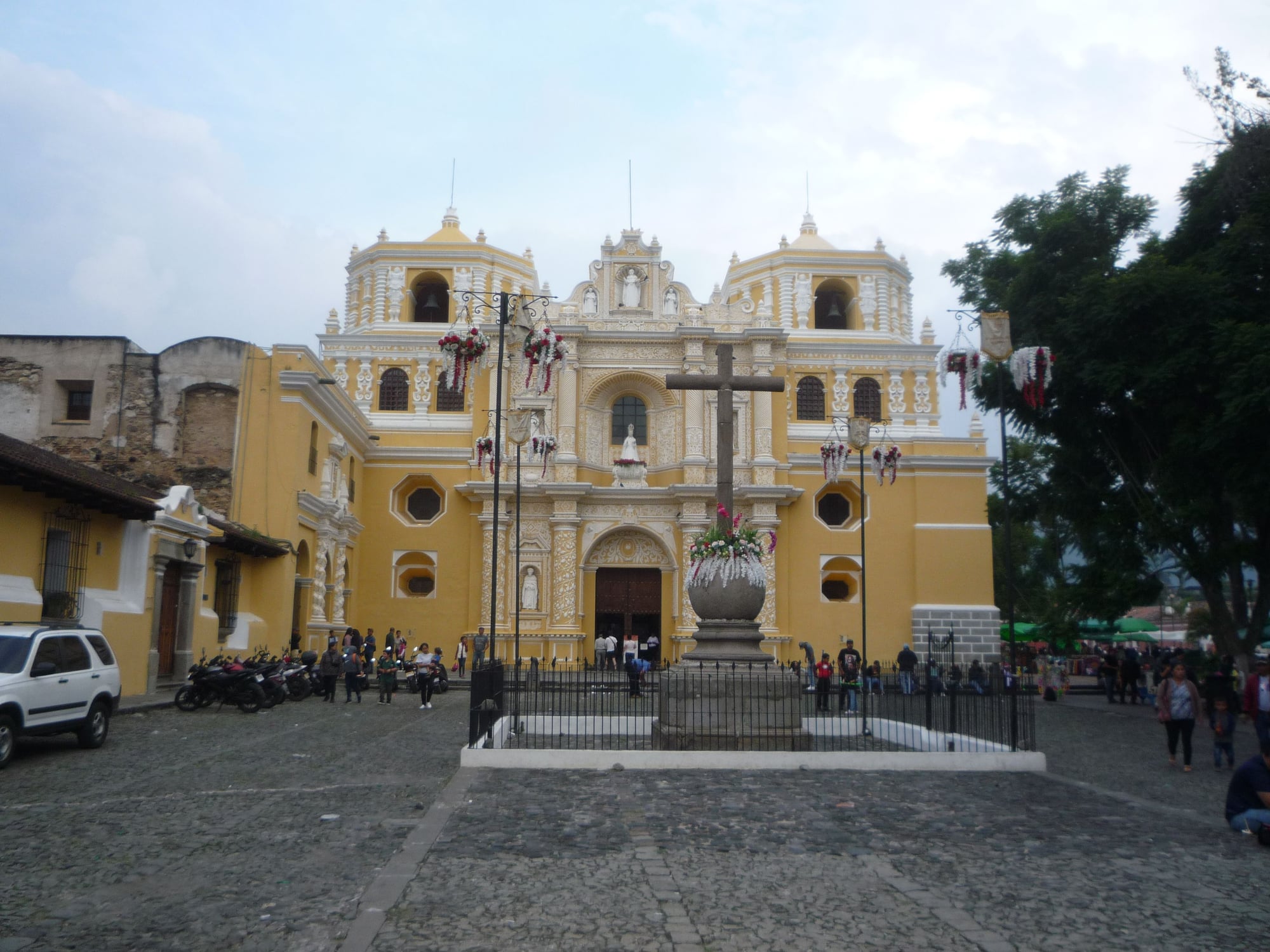
La Merced church.

Memorial to Bartolomé de las Casas, 16th-century advocate for the rights of native Americans.
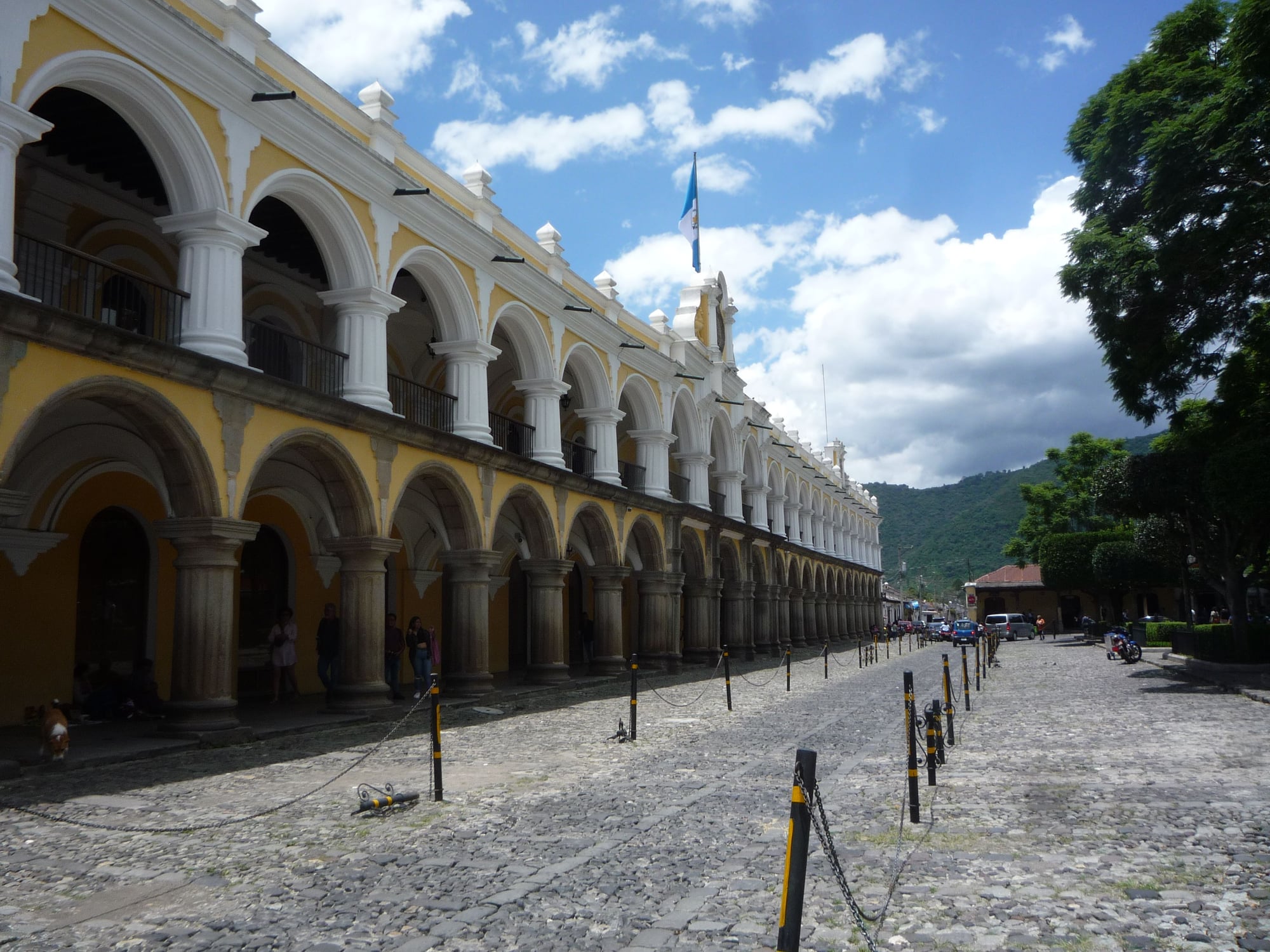
The seat of the Captains-General, who governed colonial Central America. It’s usually a lot busier than this; I must have arrived at an odd time. It now houses the splendid National Museum of Guatemalan Art.
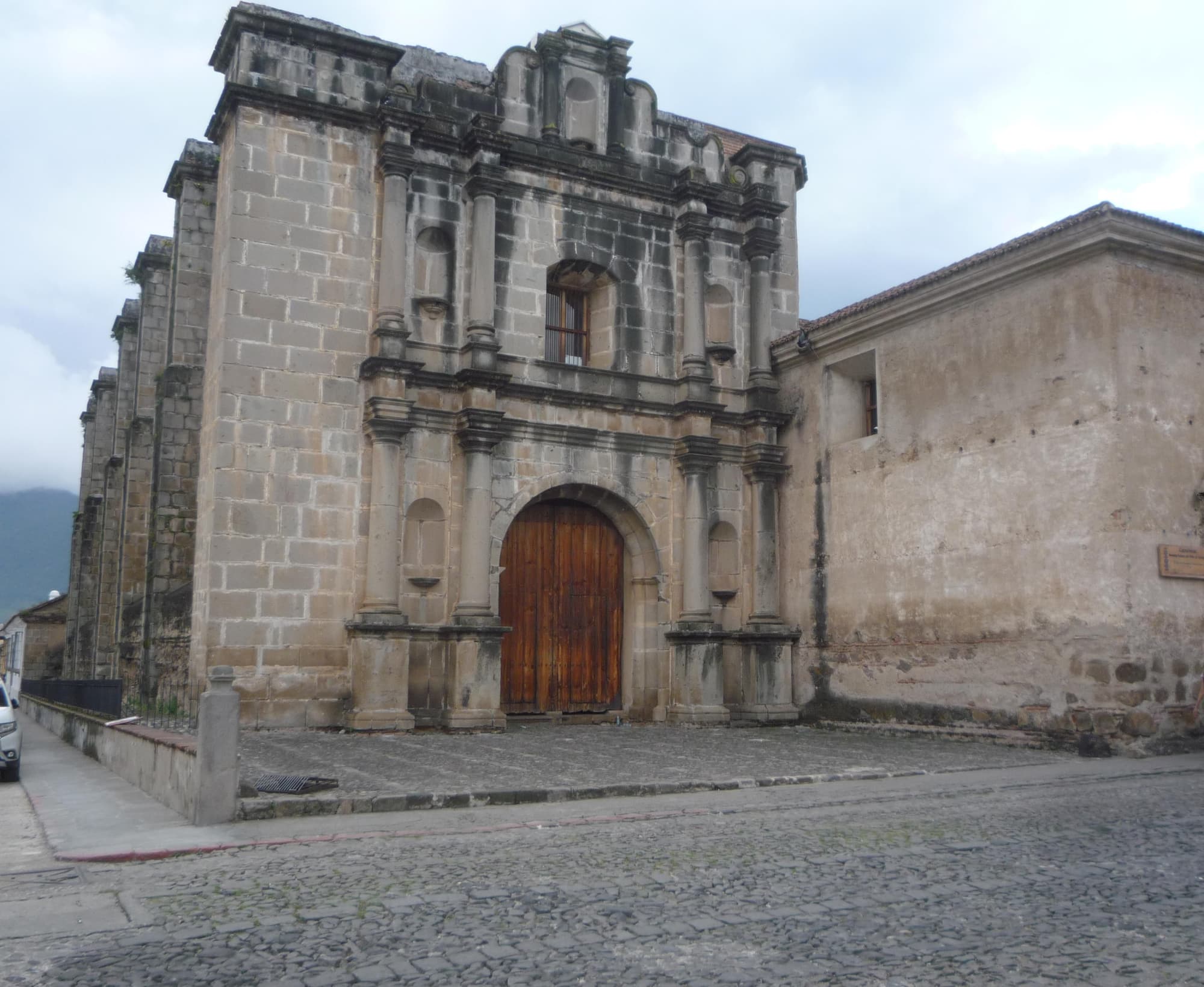
The Capuchin church.

The south-east corner of the plaza, with discarded Little Caesar’s take-out pizza box
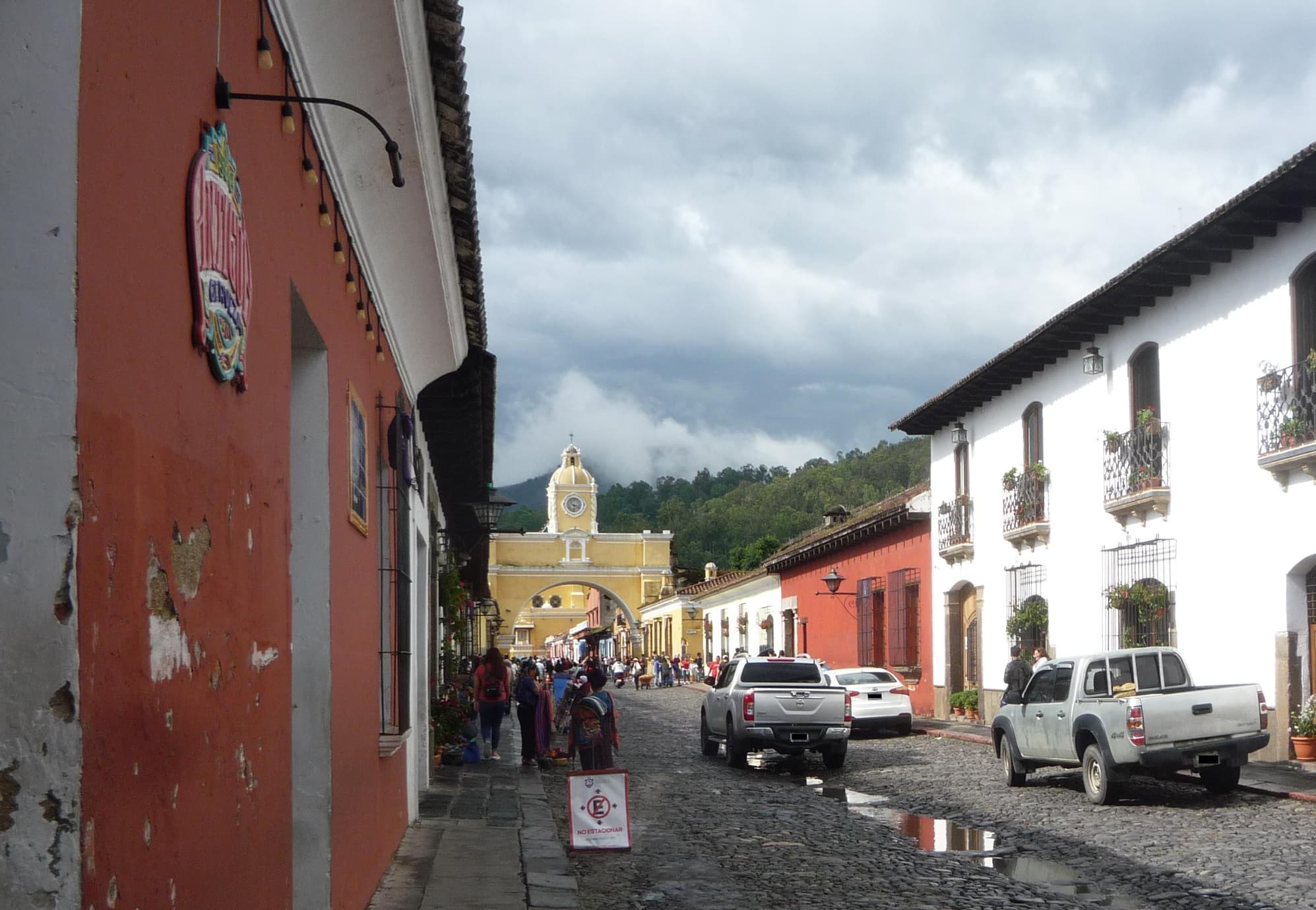
The Santa Catalina arch (of course).
The first Spanish capital of this country, the "City of the Knights of St. James of Guatemala," or Ciudad de los Caballeros de Santiago de Guatemala (the Spanish had a way with city names), was founded in 1524 where today's Tecpan Guatemala is situated, but after three years of determined resistance by the Cakchiquel Mayas, the Knights of St. James called it quits and moved about 20 miles to the south-east. This second capital lasted about 14 years, when near-by Volcan Agua, or "Water Volcano," blew. The conquistadors moved their capital once again, though only about 5 miles further, and this time lucked out — the City of the Knights of St. James #3 lasted exactly 230 years before an earthquake made a fourth (and so-far final) move mecessarily. But third capital was rebuilt, and renamed simply Antigua Guatemala, or "Old Guatemala," now just Antigua.
Antigua is one of the major tourist destinations of Guatemala, and desrvedly so. As a result there’s not really a lot I can say about it, tourism-wise, that hasn’t been said many times before; I can only agree with the best of the reviews. In fact, it is popular enough with tourists that I might have overlooked it myself; however, I happen to love spending time in old Spanish colonial towns, and anyway, Antigua is so close to the capital, and so easy to reach from there, that it's impossible to justify missing it.
But that said, I found the tourism effect palpable. Not just the very presence of tourists, but in the ways the city has adapted to them -- a much wider range of lodgings and restaurants than one might expct in an old Spanish town, numerous travel agencies, and souvenirs and traditional artefacts sold everywhere on the streets, in the plazas, and in established shops. But still, I’m willing to cut Guatemala some slack here, and refrain from complaining. For my first visit to Antigua, decades ago, was during the years of counterinsurgency, when tourism here, and elsewhere in the country, had dropped significantly. Antigua and Panajachel, so derserving of visitors, were unnaturally quiet. So today, with those reminisences in mind, I found the sight of all those tall, blond people walking about Antigua in their shorts and day-packs actually to be a good sign.
Furthermore, the tourist presence here fell far, far short of the hordes I saw in those horrifying travel-news photos from Europe this past summer. And I found that if Antigua has adapted to tourism, it has done so nicely -- it is kept up well, it remains a beautiful old Spanish city; and walking the streets in my usual "flâneur" style, I could still almost imagine from time to time, if only briefly, that I was still in the eighteenth century. (The parked cars spoiled the effect a bit.)
As I mentioned above, the many tourists who want to bail out of Guatemala City as quickly as possible can usually do so immediately from the international airport, with shuttles, taxis, and I believe even Uber going from there directly to Antigua. The trip is not excessive, Antigua not being far from the international airport, though no one seems to know quite how far — the diverse figures I’ve seen seem to converge around 24 miles, which also basically agrees with my own map measurement. Be aware that mainly due to the long winding haul through the busy Guatemala City outskirts, it may seem like a long 24 miles.
A few sights
Volcan Agua, the “Water Volcano,” is so-called because after a long period of dormancy, during which a lake had formed in its crater, the first effect after it finally blasted again in 1541 was a muddy flood cascading down. The Guatemalan scholar and writer Luis Cardoza y Aragon called Volcan Agua “the navel of Guatemala,” and ”the lookout of the original gods”, and while the world’s various societies have all had their respective ideas about where the navel of the world might be, even the agnostics among us will admit that Volcan Agua is truly what a god’s lookout ought to be, given the way it looms over the city from the south. Look down almost any south-bound street, and you’ll see it in the near distance. Enjoy breakfast on the roof-top patio of the Hotel Saleh, as I did, and it will practically be in your face. If you need an even closer look, you can hike to the top. I didn’t do so this time, though I attempted it on that earlier visit, a long time ago. (I didn’t make it to the top, but only because a tumbling stone smashed a finger of one of my companions, forcing us to rush back into town — a tricky thing to do from three-quarters of the way up a violcano — so he could get medical care.)
It seems that one of the most frequently photographed sights in Antigua is the Santa Catalina arch, which spans 5 avenue about two blocks north of the central plaza. Almost any illustrated guidebook or article on Antigua will have such a photo (one of my books has two), even if it has no others. And I admit it’s nice-looking; as arches go, though maybe not the city’s most photogenic sight. It was built in the 17th century to connect two parts of a convent, so that the nuns could cross from the one part to the other without going into the street, or even being seen. But perhaps because it appears so often in photos, it seems to attract tourists, and indeed the tourist concentration along this stretch of fifth avenue, under the arch, seemed to be far greater than what I saw anywhere else. And perhaps for that reason, the street seemed a litle tackier than most others in the city, though it’s all relative — if you could transport this stretch of fifth avenue to Zone 1 in Guatemala City, it would look fantastic. (In fact there’s a similar arch in Zone 1 of GC — even a bit nicer looking than Santa Catalina in my opinion — though it has not attracted the tourists or travel photographers yet. If arches are your scene, you’ll find that one spanning 12 calle, where it intersects 7 avenida.) But back in Antigua, once you have gazed at the Santa Catalina arch to your satisfaction, and taken your pictures, continue walking north to the elegant La Merced church, which is perhaps what more of those photographers really should be taking pictures of. Those with an interest in history, and in its better protagonists, may want to take time to admire the statue of Bartolome de las Casas, in the small square in front of the church.
At the opposite, quieter, south-east end of the city you will find the the San Francisco church and monastery. With both intact and somewhat ruined structures, I found it to be an enjoyable place just to amble about on my own; but also interesting was the story of its most famous priest, Pedro de San Jose Betancur, who resided there during the mid 17th century. One of his practices was to walk the streets of the city in the evenings, ringing a bell and asking people to pray for the souls in purgatory, which probably did not seem as odd in the 1660s as it might today. But he is known primarily for his charitable works, for which reason he is affectionately known as Hermano, or “Brother,” Pedro. Those works included miraculous cures (or so goes the official account), and a room adjacent to the church museum displays the many crutches, prosthetics, and memetos of gratitude left behind by the miraculously cured.
In the city center, I’ll also put in a good word for the ruins of the original San Jose cathedral, behind the present one. A travel companion I met up with for a couple of days declined to see it, on the not unreasonable grounds that it was, after all, smashed up; but with my sense for exploring what there is, regadless of grandeur or its lack, and also because I like large sites where I can amble about at will, I found it interesting enough. The ruins are actually impressive, and with some imagination, you can picture what a grand cathedral complex this must have been. But what I liked most was something relatively humble — on a large placard which gave a brief history of the cathedral reproduced in several languages, one of those languages was Mayan (either Cakchiquel or Quiche, I suspect), which I thought was a nice touch.
Though you can’t really miss it, I’ll call attention to the great national Museum of the Art of Guatemala (Spanish acronym MUNAG). The MUNAG was opened only two years ago, so it will be mentioned only in recent guidebooks and internet sites (the earlier museum at this site was known as the Museum of Santiago de los Caballeros). The grand building itself stretches along the entire southern side of the plaza, and in colonial times was the headquarters of the “Captains-General,” effectively the heads of government for Spanish Central America. (Technically, Central America was subordinate to the viceroy seated in Mexico City; but as the distance from that city to Guatemala was great, and as Mexico usually had enough issues of its own for the viceroy to handle, the Captain-Geneal often acted more or less independently.)
The MUNAG is a splendid museum, devoted to Guatemalan art and culture spanning the past 3000 years, right up to modern times. I’m not generally a fan of modern art, but in countries known mainly for ancient stuff, it can be interesting to see what the modern creators are doing. Don’t overlook the long first-floor balcony (second-floor in American English), from where you can gaze out over the plaza as the Captains-General themselves might have done.
As often when I’m in museums, my attention was grabbed most, not by any of the biggest, shiniest exhibits, but by a couple of the most inconspicuous ones — amidst the many ancient artefacts were two small figurines dated, rather imprecisely, to 800-250 BC, each of which resembled a wide-eyed young woman, or so it seemed to me, covering her mouth with both hands, as if interrupted in a moment of surprise or embarrassment. What impressed me was the “caught-in-time” expressiveness of these small figues, a sharp contrast with the stiff and stylized features we usually see in ancient sculpture, no matter where it’s from. Furthermore, they look exactly as people might look today if startled, though in the absence of contemporary writing, we may never know quite what the ancient artist had in mind when he made them. Honestly, if I had turned down an opportunity to see Michaelangelo’s David, in favor of these small figurines, I would have been pleased with my decision.
Hotels
My five non-consecutive nights in Antigua were spent in two reasonably-priced hotels, and I can recommend both: The Hotel Saleh, in the south-west part of the city, with more of a modern ambience (breakfast on the roof-top patio, with Volcan Agua right in front of you, is a highlight of a stay here). And the Posada de San Pedro, with a quaint ambience that goes nicely with this historic city, (I’m referring to the San Pedro on 3 avenida south, just south of 7 calle — there seemed to be a similarly-named hotel elsewhere in town.)
Dining
There are many great independent cafes and reastaurants in Antigua, and I would never recommend a global franchise to any visitor in a fine historic city like this. But if you want to live like a real Antigueño, at least for a few minutes, you may have to order a take-out pizza from the local “Little Caeser’s” place, for it seemed to be the thing to do — I constantly saw people walking about the city with their distinctive orange Little Caesar’s take-out pizza boxes in hand, often on their way to an outdoor lunch in the central plaza. (I would ask only that you toss the empty box into the trash, not onto the grass, or into a hedge, a practice not entirely unknown here.)
Otherwise, I can’t really offer any definitive recommendations, but then, you probably won’t need any, for there are cafes and restaurants of all sorts everywhere. For me, travel is primarily exploration, walking around and picking interesting-looking cafes as I pass them; and in Antigua, you usually don’t have to walk too far before passing at least a few.

Typical street scene in Antigua.

Typical street scene in Antigua.

Volcan Agua, seen from the roof-top patio of my hotel.

Fifth Avenue, just south of the plaza. The white building in the center was the birthplace (1886) of Adrian Recinos, a prominent Guatemalan scholar whose works include an authoritative Spanish translation of the Popol Vuh (the first version I read).

The San Francisco church, at the SE part of the city. It contains a museum which focuses on the life of “Brother Pedro” (Pedro de San José de Betnacur), a 17th century friar who resided here and became known for charitable and, allegedly, miraculous works.

Ruins of the original San José cathedral.

A brief history of the San José cathedral in several languages, including Chkchiquel Mayan.

La Merced church.

Memorial to Bartolomé de las Casas, 16th-century advocate for the rights of native Americans.

The seat of the Captains-General, who governed colonial Central America. It’s usually a lot busier than this; I must have arrived at an odd time. It now houses the splendid National Museum of Guatemalan Art.

The Capuchin church.

The south-east corner of the plaza, with discarded Little Caesar’s take-out pizza box

The Santa Catalina arch (of course).
#3
Original Poster
Join Date: Apr 2022
Posts: 129
Likes: 0
Received 0 Likes
on
0 Posts
Trip Report: Quetzaltenango
Quetzaltenango
While Antigua is a great place to visit, Quetzaltenango is really the kind of place I travel for. It’s not entirely unknown to tourism, but the “tourist quotient” seemed pleasantly low during my stay. In fact I could easily have felt that I was the only foreign tourist in town (I probably wasn’t!), a gratifying sensation that I could never have had in Antigua. But I must stress that the relative absence of tourism here has nothing to do with the reasons for the abnsence of tourism a few decades ago, which I mentioned in my Antigua section. Rather, it is simply the case that Quetzaltenango is just too far out there, and can’t really compete with Antigua or Lake Atitlan. Those latter two, plus Tikal, are usually sufficient for a typical two-week visit to the country; many tourists have no time, or cause, to move on any farther. (But they should.)
Quetzaltenango is a Nahua (“Aztec”) name assigned by the Mexican soldiers that accompanied Pedro de Alvarado on his invasion of Guatemala. And yes, it does refer to the bird — the name means, approximately, “place of quetzals.” The city is also — in fact quite often — known as Xelaju, or simply Xela (“Shay-la”), its original Mayan name. (Sources differ on whether this is Mam or Quiche Mayan). Leave it to the Mayas to come up with the shorter, time-saving name, which I will use henceforth.
The historic center of Xela is offers fundamentally the same old-Spanish architectural ambience that we encounter in Antigua, though without as many tourists to please it is not kept up quite as prettily. New buildings intrude on the old, there are too many graffiti, and the whole place could use a thorough paint job. It won’t present quite the consistently charming look we find in Antigua, but I prefer to think of it just as more authentic — what Antigua itself might look like if it weren’t a tourist destination. The central plaza —technically, Central-America Park — is rather grand-looking, and often very busy. On the south side of the plaza, I found a very friendly tourist-information office that was actually open when it was supposed to be.
Though I don’t have much interest in textiles or traditional clothing, my visit to the Ixkik’ Museum, which is devoted mainly to traditional Mayan textiles and clothing, was unexpectedly memorable. It’s not of traditional museum style, with everything in glass cases; rather, it’s all out there, spread out among several rooms, as if in someone’s very large attic. It clearly had been a labor of love for those who set it up. And they set it up with great care, labelling every item (in Spanish) to describe place of origin, wearer (common people, officials), and occasion (every-day, special ceremonies, etc.). In addition to the traditional clothing, there were displays of contemporary but traditional Mayan artefacts, and several wall posters (again, only in Spanish) describing various aspects of contemporary Mayan culture.
There are some curious reminders of the city’s history here and there. I was personally intrigued by the large monument in the plaza in honor of Justo Rufino Barrios, a liberal Guatemalan president of the 1870s, who doesn’t come off quite so well in the neighboring Central American countries, which Barrios invaded in ordet to impose —successfully, in the case of Honduras — liberal governments like his own. In an act of courage rarely seen among today’s heads of state, Barrios personally led his army into El Salvador — then got killed on the field. (Note that in 19th-century Latin America, “Liberalism” did not quite mean what it does today; in particular, it was often a disaster for indigenous communities.) Also, one of the streets leading from the plaza (5 calle, I think) was informally named after Honduran General Francisco Morazan, which is a quiet reminder that while many of Guatemala’s leaders fiercely opposed Morazan’s efforts to unite Central America under a republican constitution (1823-1840), Xela supported him, to the extent of seceding from Guatemala in 1838, along with most of western Guatemala. (They got away with it for two years, before being forced back in. The short-lived country, which called itself Los Altos, tried again in 1848, and lasted eight months.)
And then there is the block of 6 street just off the plaza named in honor of Manuel Estrada, the early 20th-century Guatemalan president who was, according to most literary experts, the subject of the great Guatemalan novel El Señor Presidente (“Mr. President”) by Miguel Angel Asturias, a future Nobel Prize recipient. For this reason, and many others, Estrada’s 22 years in office make for rather curious reading. Notably curious was Estrada’s personal cult of Minerva, the goddess of wisdom (the Roman equivalent — appropriate for a Latin country, I guess — of the Greek Athena). In Xela you can still visit one of the nine large, Greek-style Minerva temples that Estrada commissioned throughout the country. (In the end Estrada got little in return for his devotion — Minerva failed to keep her number-one acolyte from being deposed, and sent to prison, in 1920.)
The Minerva Temple, and the Ixkik’ Museum described above, are in what I might call the “modern” part of Xela (north of Rodolfo Robles Street), though I don’t mean by this that you would necessarily want to lodge here. The area seemed safe enough, though not very aesthetic; basically a rather plain though busy area built, it seems, for business and shopping, and little else. It’s centered on a multi-story, US-style shopping mall, which, if you need it, is on 15 avenida, not far from the old train station. (Presumably there is a railroad museum there, but it didn’t seem to be open at the time of my visit.) You may also want to check out the Benito Juarez park, a few blocks further east, where you’ll find a replica of the famlous Aztec “calendar stone,” and across the street, the unique, spiffy new San Nicolas church. I should add that while the historic center didn’t have quite the resored charm of Antigua, and the newer area had hardly any at all, I found the city to be safe; I neither experienced problems, nor even sensed anything to worry about.
There are several interesting day trips possible. I wasn’t able to make it to any of them myself, but places you may want to look into include the sacred lake Chicabal; Salcaja, known for arteienal drinks, traditional textiles, and the oldest surviving church in Central America; Zunil, a center of contemporary Mayan culture; and the Cerro Sija Ecological Park. The welcoming Tourist Information office will be able to help you with visiting these destinations.
Some practicalities
Fortunately you no longer have to deal with those famous “chicken buses” if you want to visit Xela. There are two major bus companies, Xelabus and Alamo, which go to Xela from terminals in one of the western neighborhoods of Guatemala City, and several tourist agencies, like Monte Verde Tours and Adrenalina Tours, which operate shared tourist shuttles (and private cars, if you wan to to pay for one) from both the capital and Antigua.
For lodging, I can strongly recommend the Hotel Muchá (formerly Mucha Arte) in the historic center, a few blocks from the plaza. For cafe-style dining, check out La Stampa Bistro, on the north-east corner of the central plaza. (A bit below street level.)
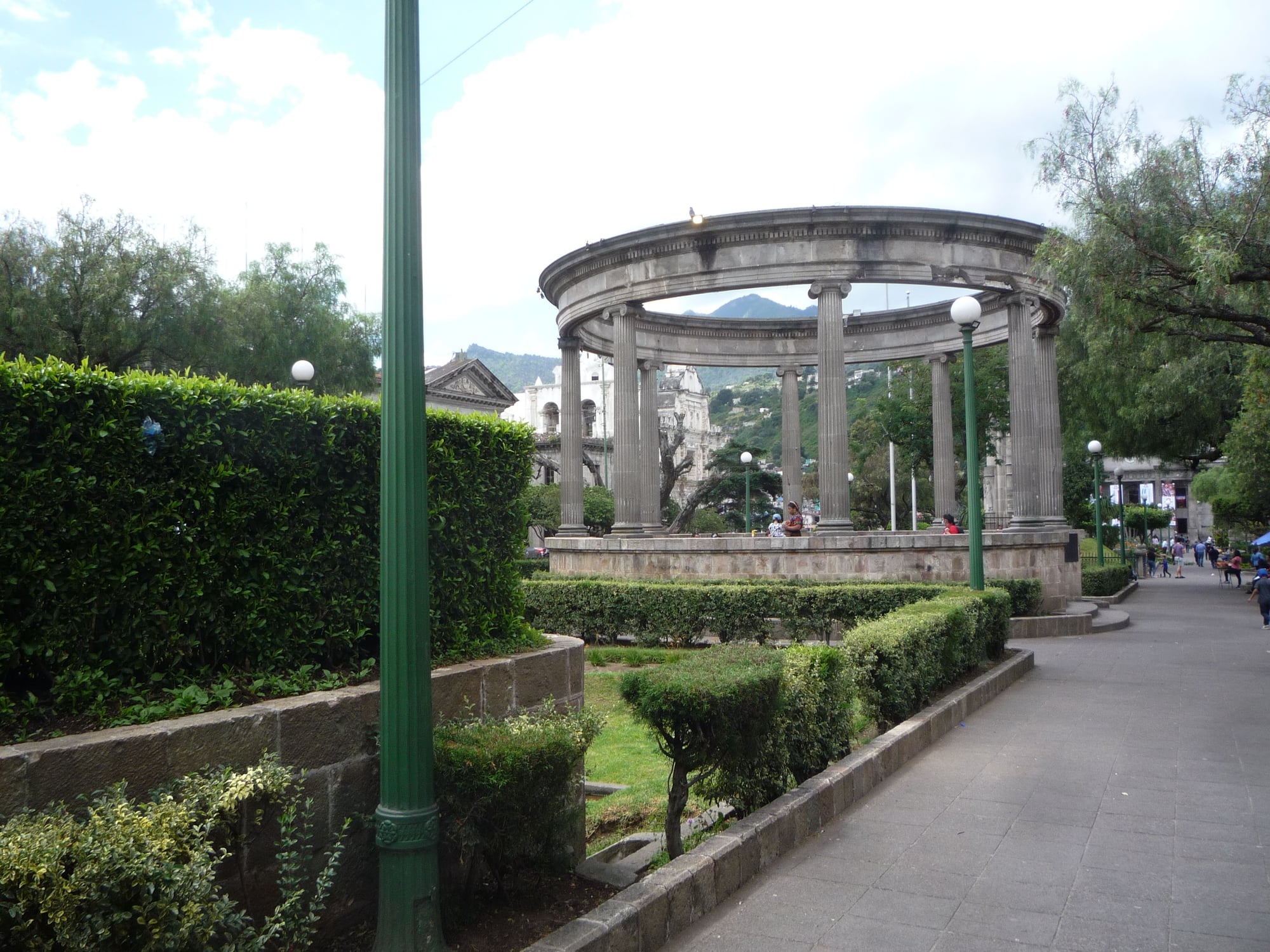
Looking south down the central Plaza (“Central America Park”). Through the rotunda, towards the left, you can see the facade of the Holy Spirit (Espiritu Santo) cathedral, finished in 1540. It’s not obvious from here, but the facade is all that’s left of it.
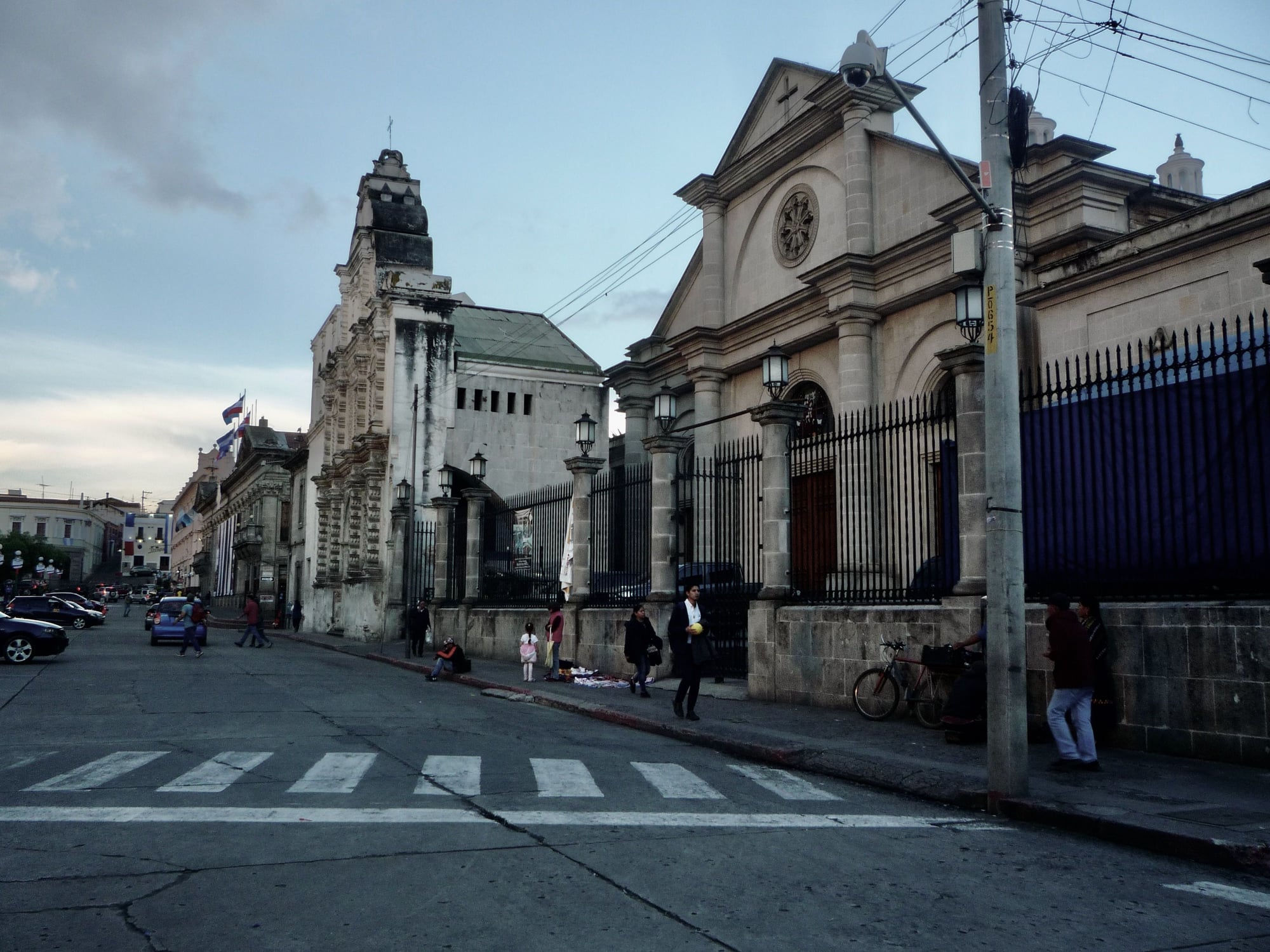
The facade of the Holy Spirit cathedral, from the south side of the plaza. Due mainly to earthquakes, the cathedral was damaged and reconstructed several times, until finally, at the end of the 19th century, they just gave up and started building the new one, which was slipped in behind the old facade.
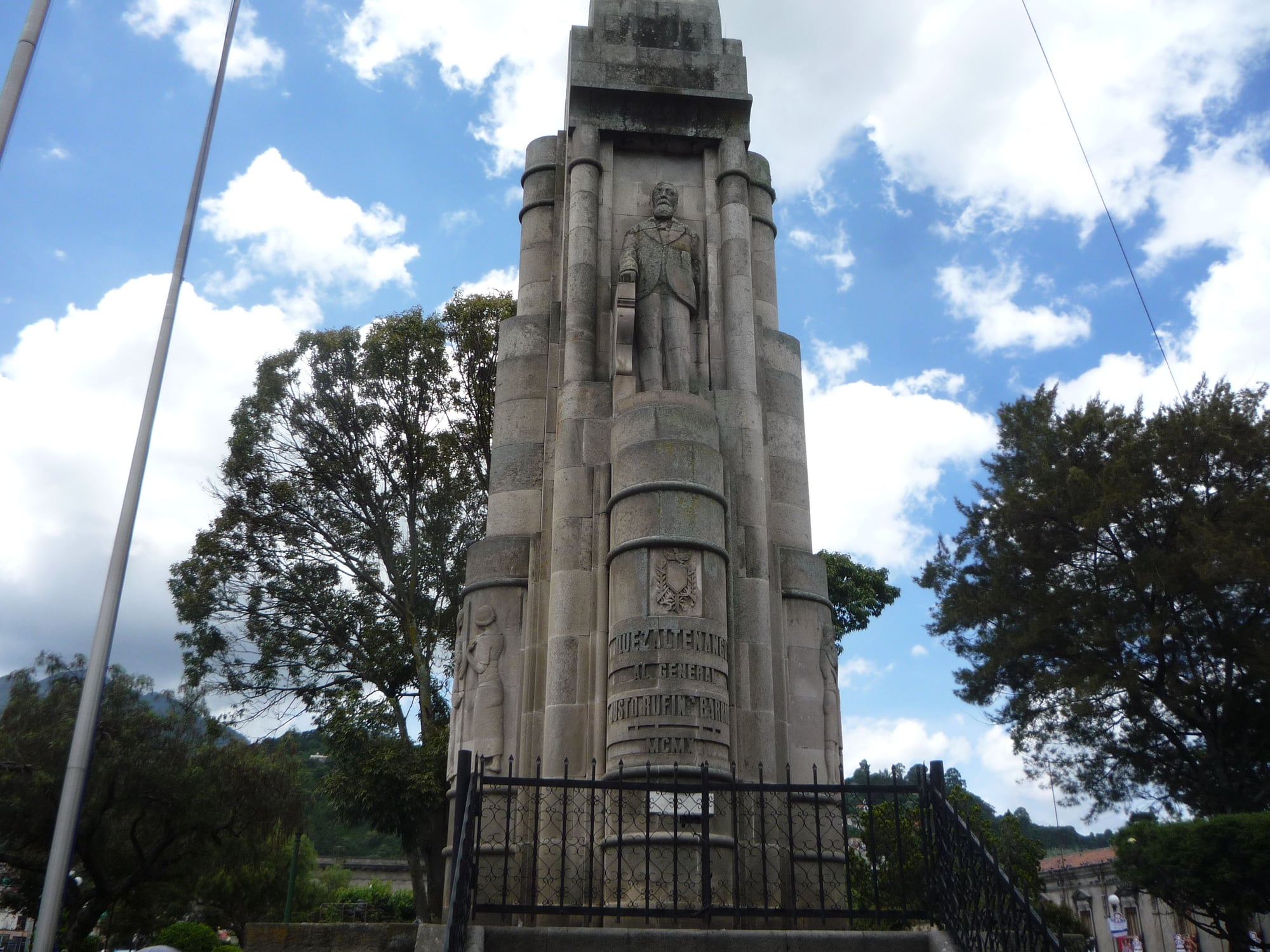
Monument to Justo Rufino Barrios (central plaza), president of Guatemala (1873-1875), credited with having led, or forced, Guatemala into the modern age of business and industry, known in Guatemala as the Age of Reform.
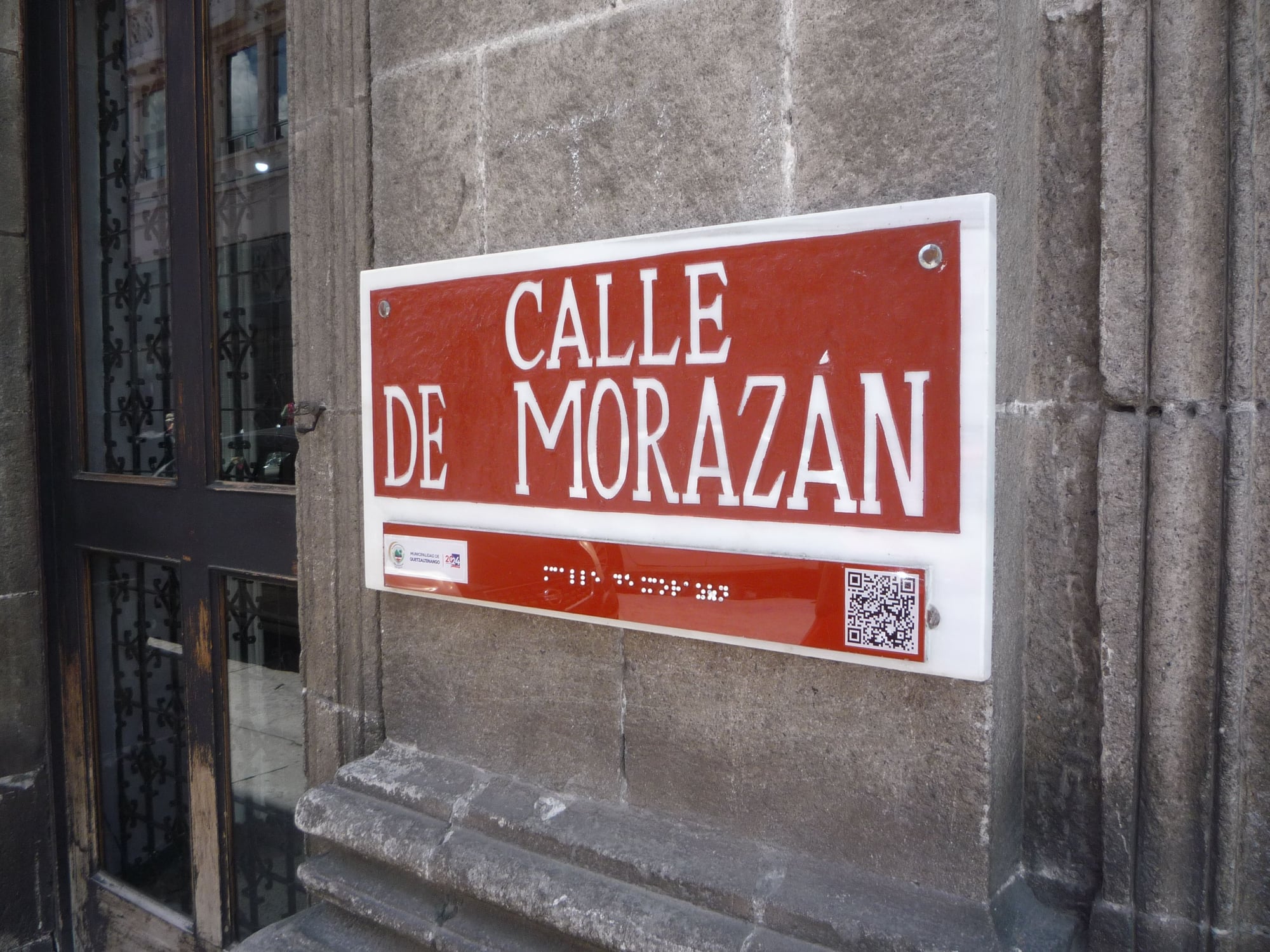
A block named in honor of General Francisco Morazan, who attempted, ultimately without success, to keep Central; America united under a republican constitution (1820s and 30s). Some of his most dedicated opponents were conservative Guatemalan leaders, but Xela supported him.

The north-east corner of the central plaza.

Typical street in the historic center of Xela.
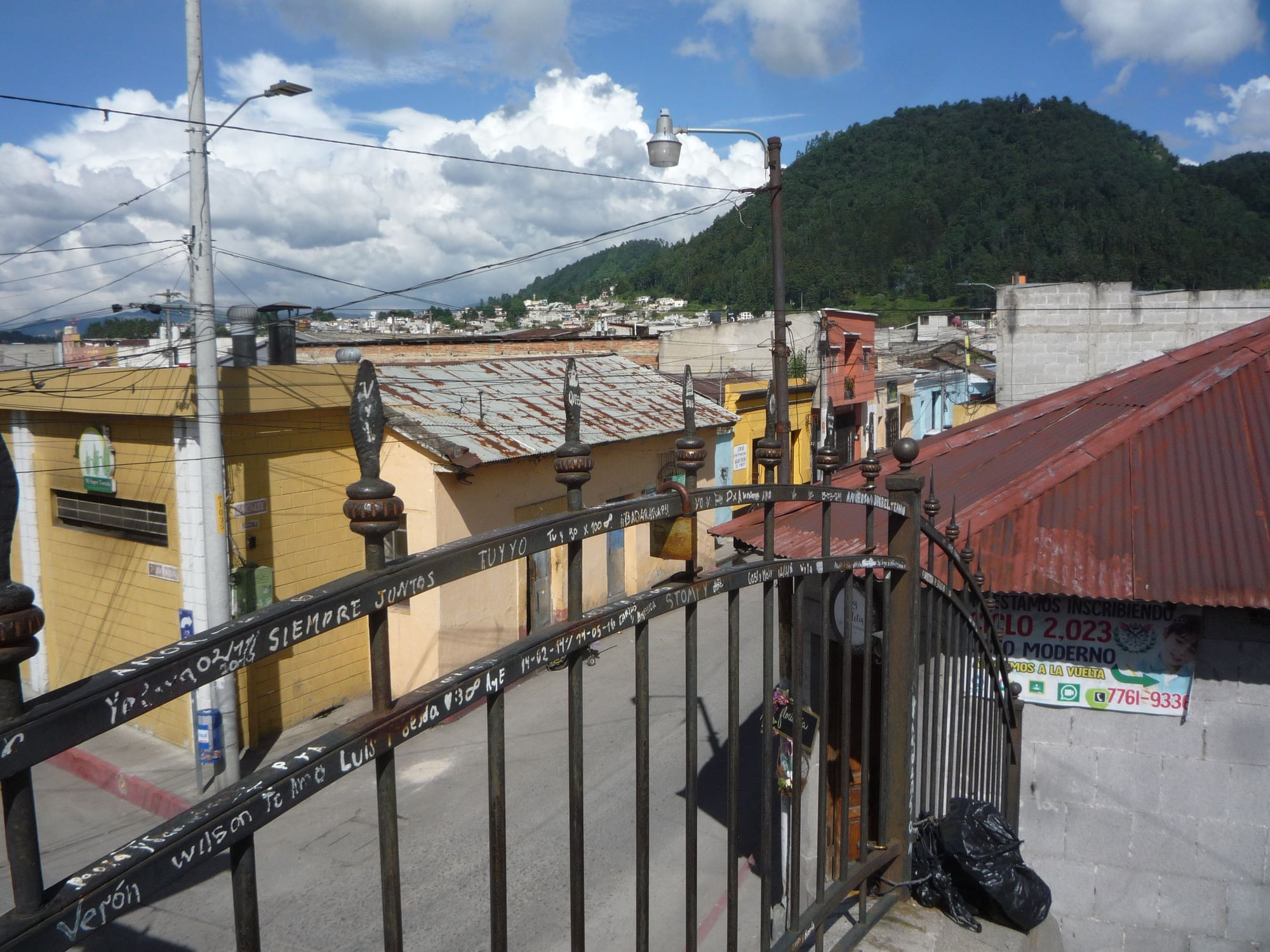
Typical street in the historic center of Xela.

In the newer part of Xela: looking south down 20 avenida from in front of the Ixkik' Museum.
While Antigua is a great place to visit, Quetzaltenango is really the kind of place I travel for. It’s not entirely unknown to tourism, but the “tourist quotient” seemed pleasantly low during my stay. In fact I could easily have felt that I was the only foreign tourist in town (I probably wasn’t!), a gratifying sensation that I could never have had in Antigua. But I must stress that the relative absence of tourism here has nothing to do with the reasons for the abnsence of tourism a few decades ago, which I mentioned in my Antigua section. Rather, it is simply the case that Quetzaltenango is just too far out there, and can’t really compete with Antigua or Lake Atitlan. Those latter two, plus Tikal, are usually sufficient for a typical two-week visit to the country; many tourists have no time, or cause, to move on any farther. (But they should.)
Quetzaltenango is a Nahua (“Aztec”) name assigned by the Mexican soldiers that accompanied Pedro de Alvarado on his invasion of Guatemala. And yes, it does refer to the bird — the name means, approximately, “place of quetzals.” The city is also — in fact quite often — known as Xelaju, or simply Xela (“Shay-la”), its original Mayan name. (Sources differ on whether this is Mam or Quiche Mayan). Leave it to the Mayas to come up with the shorter, time-saving name, which I will use henceforth.
The historic center of Xela is offers fundamentally the same old-Spanish architectural ambience that we encounter in Antigua, though without as many tourists to please it is not kept up quite as prettily. New buildings intrude on the old, there are too many graffiti, and the whole place could use a thorough paint job. It won’t present quite the consistently charming look we find in Antigua, but I prefer to think of it just as more authentic — what Antigua itself might look like if it weren’t a tourist destination. The central plaza —technically, Central-America Park — is rather grand-looking, and often very busy. On the south side of the plaza, I found a very friendly tourist-information office that was actually open when it was supposed to be.
Though I don’t have much interest in textiles or traditional clothing, my visit to the Ixkik’ Museum, which is devoted mainly to traditional Mayan textiles and clothing, was unexpectedly memorable. It’s not of traditional museum style, with everything in glass cases; rather, it’s all out there, spread out among several rooms, as if in someone’s very large attic. It clearly had been a labor of love for those who set it up. And they set it up with great care, labelling every item (in Spanish) to describe place of origin, wearer (common people, officials), and occasion (every-day, special ceremonies, etc.). In addition to the traditional clothing, there were displays of contemporary but traditional Mayan artefacts, and several wall posters (again, only in Spanish) describing various aspects of contemporary Mayan culture.
There are some curious reminders of the city’s history here and there. I was personally intrigued by the large monument in the plaza in honor of Justo Rufino Barrios, a liberal Guatemalan president of the 1870s, who doesn’t come off quite so well in the neighboring Central American countries, which Barrios invaded in ordet to impose —successfully, in the case of Honduras — liberal governments like his own. In an act of courage rarely seen among today’s heads of state, Barrios personally led his army into El Salvador — then got killed on the field. (Note that in 19th-century Latin America, “Liberalism” did not quite mean what it does today; in particular, it was often a disaster for indigenous communities.) Also, one of the streets leading from the plaza (5 calle, I think) was informally named after Honduran General Francisco Morazan, which is a quiet reminder that while many of Guatemala’s leaders fiercely opposed Morazan’s efforts to unite Central America under a republican constitution (1823-1840), Xela supported him, to the extent of seceding from Guatemala in 1838, along with most of western Guatemala. (They got away with it for two years, before being forced back in. The short-lived country, which called itself Los Altos, tried again in 1848, and lasted eight months.)
And then there is the block of 6 street just off the plaza named in honor of Manuel Estrada, the early 20th-century Guatemalan president who was, according to most literary experts, the subject of the great Guatemalan novel El Señor Presidente (“Mr. President”) by Miguel Angel Asturias, a future Nobel Prize recipient. For this reason, and many others, Estrada’s 22 years in office make for rather curious reading. Notably curious was Estrada’s personal cult of Minerva, the goddess of wisdom (the Roman equivalent — appropriate for a Latin country, I guess — of the Greek Athena). In Xela you can still visit one of the nine large, Greek-style Minerva temples that Estrada commissioned throughout the country. (In the end Estrada got little in return for his devotion — Minerva failed to keep her number-one acolyte from being deposed, and sent to prison, in 1920.)
The Minerva Temple, and the Ixkik’ Museum described above, are in what I might call the “modern” part of Xela (north of Rodolfo Robles Street), though I don’t mean by this that you would necessarily want to lodge here. The area seemed safe enough, though not very aesthetic; basically a rather plain though busy area built, it seems, for business and shopping, and little else. It’s centered on a multi-story, US-style shopping mall, which, if you need it, is on 15 avenida, not far from the old train station. (Presumably there is a railroad museum there, but it didn’t seem to be open at the time of my visit.) You may also want to check out the Benito Juarez park, a few blocks further east, where you’ll find a replica of the famlous Aztec “calendar stone,” and across the street, the unique, spiffy new San Nicolas church. I should add that while the historic center didn’t have quite the resored charm of Antigua, and the newer area had hardly any at all, I found the city to be safe; I neither experienced problems, nor even sensed anything to worry about.
There are several interesting day trips possible. I wasn’t able to make it to any of them myself, but places you may want to look into include the sacred lake Chicabal; Salcaja, known for arteienal drinks, traditional textiles, and the oldest surviving church in Central America; Zunil, a center of contemporary Mayan culture; and the Cerro Sija Ecological Park. The welcoming Tourist Information office will be able to help you with visiting these destinations.
Some practicalities
Fortunately you no longer have to deal with those famous “chicken buses” if you want to visit Xela. There are two major bus companies, Xelabus and Alamo, which go to Xela from terminals in one of the western neighborhoods of Guatemala City, and several tourist agencies, like Monte Verde Tours and Adrenalina Tours, which operate shared tourist shuttles (and private cars, if you wan to to pay for one) from both the capital and Antigua.
For lodging, I can strongly recommend the Hotel Muchá (formerly Mucha Arte) in the historic center, a few blocks from the plaza. For cafe-style dining, check out La Stampa Bistro, on the north-east corner of the central plaza. (A bit below street level.)

Looking south down the central Plaza (“Central America Park”). Through the rotunda, towards the left, you can see the facade of the Holy Spirit (Espiritu Santo) cathedral, finished in 1540. It’s not obvious from here, but the facade is all that’s left of it.

The facade of the Holy Spirit cathedral, from the south side of the plaza. Due mainly to earthquakes, the cathedral was damaged and reconstructed several times, until finally, at the end of the 19th century, they just gave up and started building the new one, which was slipped in behind the old facade.

Monument to Justo Rufino Barrios (central plaza), president of Guatemala (1873-1875), credited with having led, or forced, Guatemala into the modern age of business and industry, known in Guatemala as the Age of Reform.

A block named in honor of General Francisco Morazan, who attempted, ultimately without success, to keep Central; America united under a republican constitution (1820s and 30s). Some of his most dedicated opponents were conservative Guatemalan leaders, but Xela supported him.

The north-east corner of the central plaza.

Typical street in the historic center of Xela.

Typical street in the historic center of Xela.

In the newer part of Xela: looking south down 20 avenida from in front of the Ixkik' Museum.
Last edited by Faedus; Nov 17th, 2023 at 03:00 PM.
#4
Join Date: Apr 2023
Posts: 110
Likes: 0
Received 0 Likes
on
0 Posts
Nice report, F. We traveled to Guatemala I think it was '98 &' 99, just a couple of years after the civil war ended. Primarily to study Spanish in Antigua. Which indeed is a lovely city. I rather liked GC, from what we saw of it. One day we asked our Spanish teachers to take us on a 'field trip' to the city, which was fun, on the second trip, we spent 3 days there. Pics bring back good memories. We did do a weekend trip to Panajachel. My recollection about the church & convent ruins was that if they couldn't be restored to their former glory, the ruins were to be left as they were after the earthquake. Made for an interesting ambiance.
#6
Join Date: Jan 2003
Posts: 3,465
Likes: 0
Received 0 Likes
on
0 Posts
Faedus—
As always, I enjoy your trip reports. My thoughts on both Guatemala City and Antigua bore considerable similarity to yours.
Antigua I first wondered whether I would enjoy given an initial thought that given the relatively large number of foreign tourists for the region, it would be less interesting. However, the former capital won me over for many reasons, with the scenic setting, architectural beauty, rich history, enjoyable activities, not to mention some utterly phenomenal mangoes sold by street vendors being among them. I took a cooking course there in 2016 which to this day is one of my favourite travel memories. I plead guilty to lingering to savour the Arco Santa Catalina with the Volcán Agua as backdrop, as well as trying to get a decent photo —sorry I missed the arch you mention in GC.
—sorry I missed the arch you mention in GC.
As for GC, while both visits there, like many I stayed in or near the Zona 10, a neighbourhood which does have a fun energy about it and I appreciated for its proximity to the Museo Popol Vuh, I did make it down to the Zona 1 on a bit of a crazy jaunt via public transit. I enjoyed reminiscing looking at your pictures of the area, especially the plaza with the cathedral. I remember thinking the plaza was grand but also wishing there were more reasons to linger such as less concrete and more vegetation, more shady places to sit and possibly dining.
Thanks for the great report! Daniel
As always, I enjoy your trip reports. My thoughts on both Guatemala City and Antigua bore considerable similarity to yours.
Antigua I first wondered whether I would enjoy given an initial thought that given the relatively large number of foreign tourists for the region, it would be less interesting. However, the former capital won me over for many reasons, with the scenic setting, architectural beauty, rich history, enjoyable activities, not to mention some utterly phenomenal mangoes sold by street vendors being among them. I took a cooking course there in 2016 which to this day is one of my favourite travel memories. I plead guilty to lingering to savour the Arco Santa Catalina with the Volcán Agua as backdrop, as well as trying to get a decent photo
 —sorry I missed the arch you mention in GC.
—sorry I missed the arch you mention in GC.As for GC, while both visits there, like many I stayed in or near the Zona 10, a neighbourhood which does have a fun energy about it and I appreciated for its proximity to the Museo Popol Vuh, I did make it down to the Zona 1 on a bit of a crazy jaunt via public transit. I enjoyed reminiscing looking at your pictures of the area, especially the plaza with the cathedral. I remember thinking the plaza was grand but also wishing there were more reasons to linger such as less concrete and more vegetation, more shady places to sit and possibly dining.
Thanks for the great report! Daniel
#7
Original Poster
Join Date: Apr 2022
Posts: 129
Likes: 0
Received 0 Likes
on
0 Posts
Thanks for the comments. Good to hear from Baldone again; it’s nice to get an approving comment from the dean of Mexico reporting. I’m still striving to post pictures that match the quality of your own. And I agree, “Brother-devil,” I guess I do veer a little from the usual travel topics. I’ve found, though, that each of the Central American countries I’ve visited (all five former Federation members) has a much richer literary, cultural, and intellectual tradition than one might guess from the dismal way these countries are portrayed in our media. I try in these reports at least to provide some hints about this, without, I hope, over-doing it, or sounding too “academic.”.
Daniel: I looked at your San Salvador-to-Copan report from 2019, since I’m planning (though it’s not definite yet) to visit El Salvador next year. And though that report did not deal with El Salvador in depth, your reporting, plus the accompanying “thread” of comments, made for very interesting reading. In fact, though it’s years too late, I added a comment at the end, which at least had the salutary effect of brining that report up to the top for the time being — for I think it is as relevant now as it was when you posted it. (And you’re right, Antigua does seem to have a way of winning people over.)
Daniel: I looked at your San Salvador-to-Copan report from 2019, since I’m planning (though it’s not definite yet) to visit El Salvador next year. And though that report did not deal with El Salvador in depth, your reporting, plus the accompanying “thread” of comments, made for very interesting reading. In fact, though it’s years too late, I added a comment at the end, which at least had the salutary effect of brining that report up to the top for the time being — for I think it is as relevant now as it was when you posted it. (And you’re right, Antigua does seem to have a way of winning people over.)
#8
Join Date: Jan 2003
Posts: 3,465
Likes: 0
Received 0 Likes
on
0 Posts
Hi Faedus
Indeed the report San Salvador to Copán was not about El Salvador at all but more the archaeological sites I visited after a jaunt in El Salvador. I did write a report on El Salvador although it’s at the tail end of a cross-Mexico journey, linked below. I maybe should have separated it, to make it easier to find. Anyway the El Salvador part is at the end of this report. There’s more on Mexico in it, from Austin to Monterrey to Tampico to Veracruz to Tuxtla Gutiérrez to Tapachula, but once you get past all that, I have some posts on El Salvador.
Buses: Austin & Mexican Gulf Coast to El Salvador
Thanks again for a great report
Daniel
Indeed the report San Salvador to Copán was not about El Salvador at all but more the archaeological sites I visited after a jaunt in El Salvador. I did write a report on El Salvador although it’s at the tail end of a cross-Mexico journey, linked below. I maybe should have separated it, to make it easier to find. Anyway the El Salvador part is at the end of this report. There’s more on Mexico in it, from Austin to Monterrey to Tampico to Veracruz to Tuxtla Gutiérrez to Tapachula, but once you get past all that, I have some posts on El Salvador.
Buses: Austin & Mexican Gulf Coast to El Salvador
Thanks again for a great report
Daniel
Thread
Original Poster
Forum
Replies
Last Post
gimmerumi1
Mexico & Central America
2
Jun 11th, 2012 11:35 AM






